University Project Management: SIM 335 Assessment Report
VerifiedAdded on 2023/01/18

SIM 335 Managing Projects Assessment Question
[Student Name]
[Student ID]
Paraphrase This Document
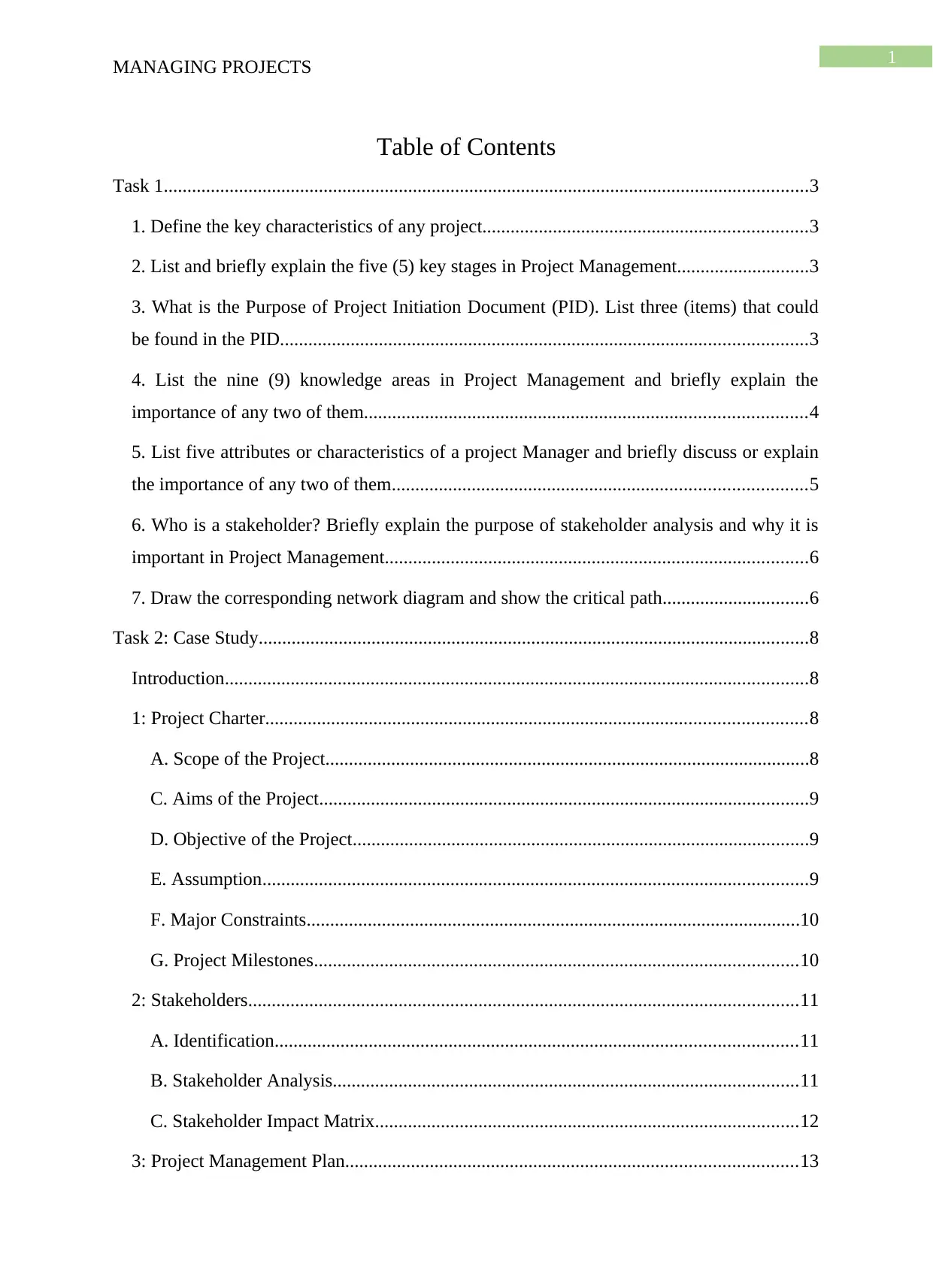
MANAGING PROJECTS
Table of Contents
Task 1.........................................................................................................................................3
1. Define the key characteristics of any project.....................................................................3
2. List and briefly explain the five (5) key stages in Project Management............................3
3. What is the Purpose of Project Initiation Document (PID). List three (items) that could
be found in the PID................................................................................................................3
4. List the nine (9) knowledge areas in Project Management and briefly explain the
importance of any two of them..............................................................................................4
5. List five attributes or characteristics of a project Manager and briefly discuss or explain
the importance of any two of them........................................................................................5
6. Who is a stakeholder? Briefly explain the purpose of stakeholder analysis and why it is
important in Project Management..........................................................................................6
7. Draw the corresponding network diagram and show the critical path...............................6
Task 2: Case Study.....................................................................................................................8
Introduction............................................................................................................................8
1: Project Charter...................................................................................................................8
A. Scope of the Project.......................................................................................................8
C. Aims of the Project........................................................................................................9
D. Objective of the Project.................................................................................................9
E. Assumption....................................................................................................................9
F. Major Constraints.........................................................................................................10
G. Project Milestones.......................................................................................................10
2: Stakeholders.....................................................................................................................11
A. Identification...............................................................................................................11
B. Stakeholder Analysis...................................................................................................11
C. Stakeholder Impact Matrix..........................................................................................12
3: Project Management Plan................................................................................................13
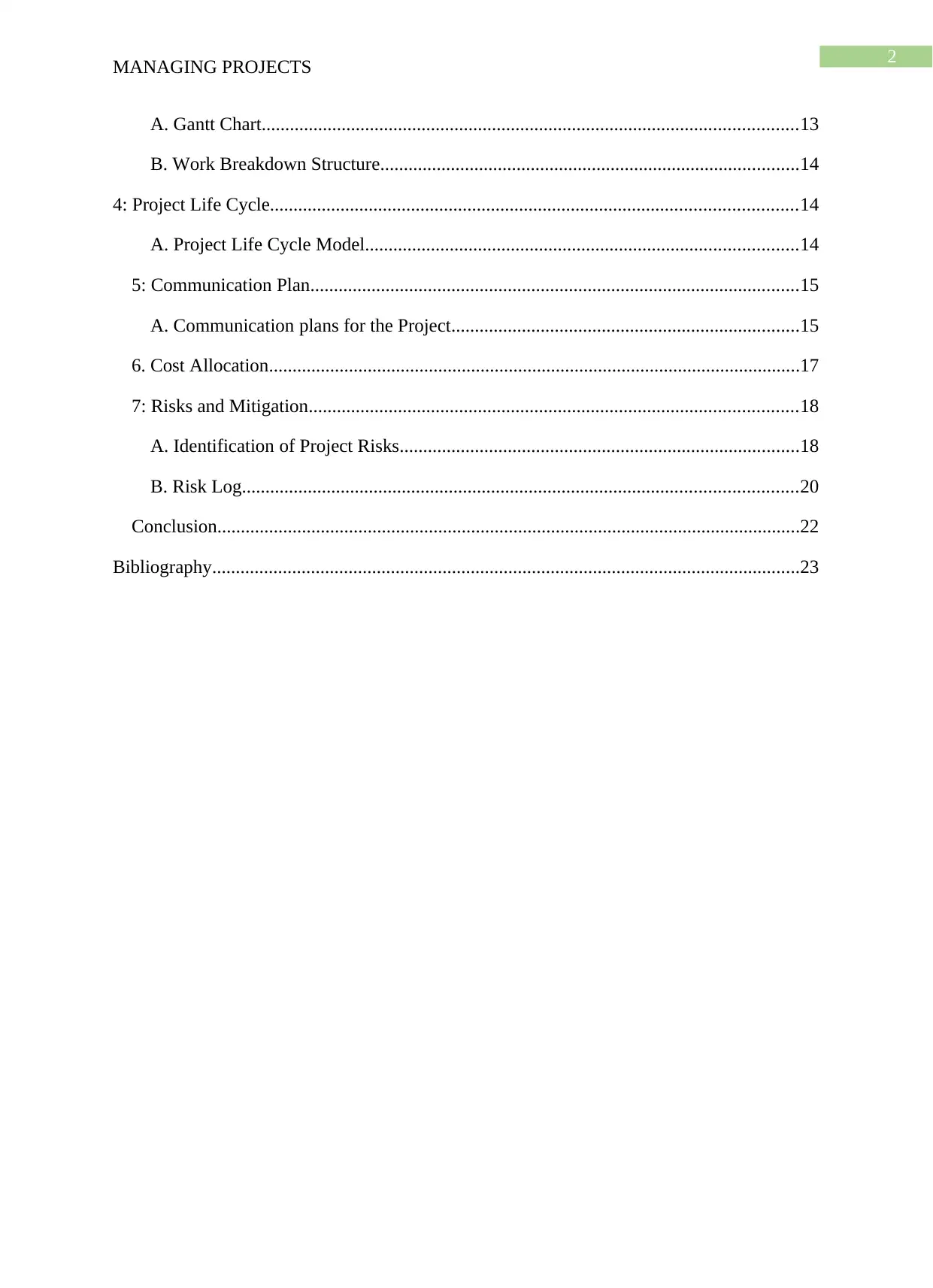
MANAGING PROJECTS
A. Gantt Chart..................................................................................................................13
B. Work Breakdown Structure.........................................................................................14
4: Project Life Cycle................................................................................................................14
A. Project Life Cycle Model............................................................................................14
5: Communication Plan........................................................................................................15
A. Communication plans for the Project..........................................................................15
6. Cost Allocation.................................................................................................................17
7: Risks and Mitigation........................................................................................................18
A. Identification of Project Risks.....................................................................................18
B. Risk Log......................................................................................................................20
Conclusion............................................................................................................................22
Bibliography.............................................................................................................................23
⊘ This is a preview!⊘
Do you want full access?
Subscribe today to unlock all pages.

Trusted by 1+ million students worldwide
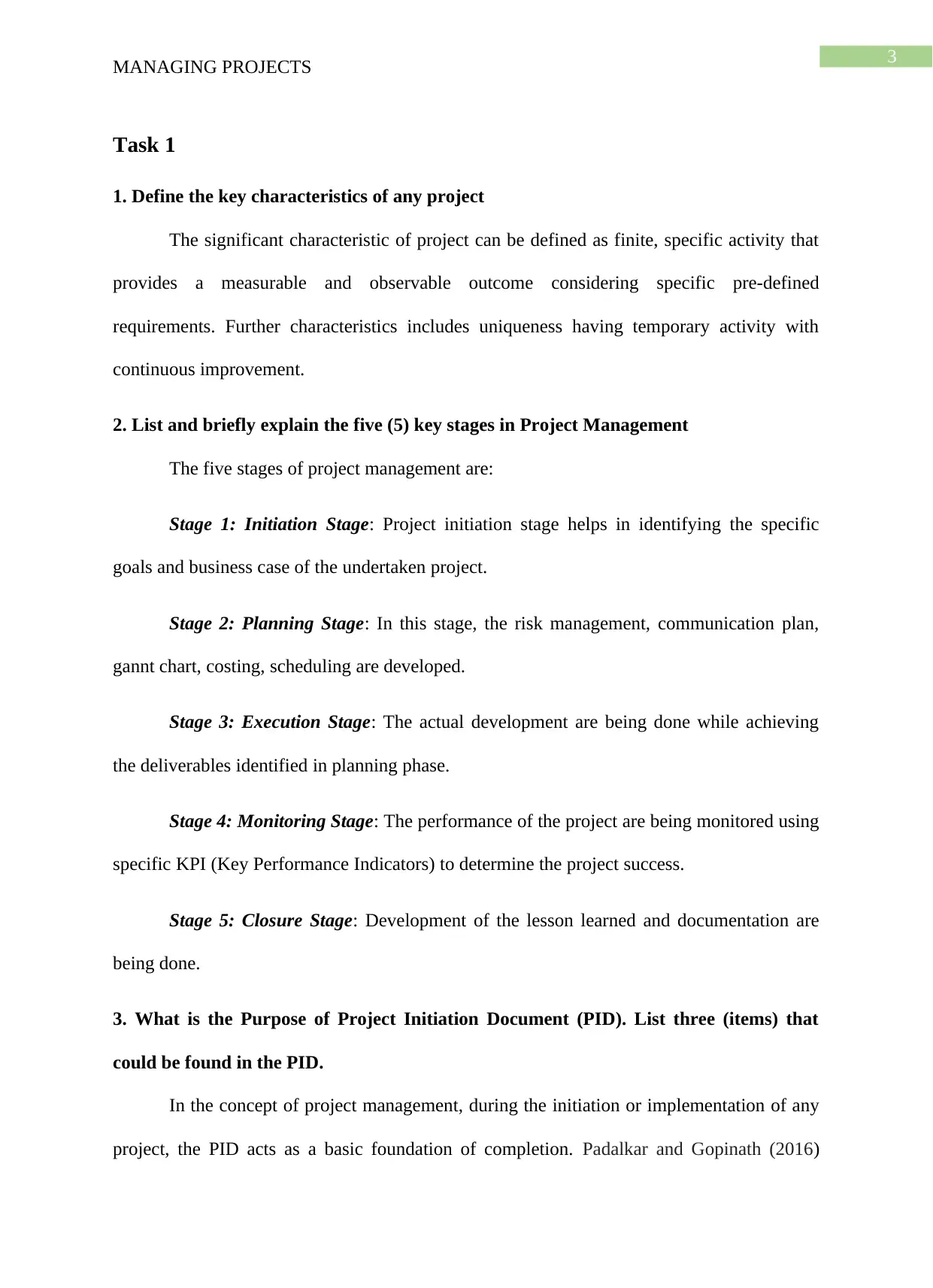
MANAGING PROJECTS
Task 1
1. Define the key characteristics of any project
The significant characteristic of project can be defined as finite, specific activity that
provides a measurable and observable outcome considering specific pre-defined
requirements. Further characteristics includes uniqueness having temporary activity with
continuous improvement.
2. List and briefly explain the five (5) key stages in Project Management
The five stages of project management are:
Stage 1: Initiation Stage: Project initiation stage helps in identifying the specific
goals and business case of the undertaken project.
Stage 2: Planning Stage: In this stage, the risk management, communication plan,
gannt chart, costing, scheduling are developed.
Stage 3: Execution Stage: The actual development are being done while achieving
the deliverables identified in planning phase.
Stage 4: Monitoring Stage: The performance of the project are being monitored using
specific KPI (Key Performance Indicators) to determine the project success.
Stage 5: Closure Stage: Development of the lesson learned and documentation are
being done.
3. What is the Purpose of Project Initiation Document (PID). List three (items) that
could be found in the PID.
In the concept of project management, during the initiation or implementation of any
project, the PID acts as a basic foundation of completion. Padalkar and Gopinath (2016)
Paraphrase This Document
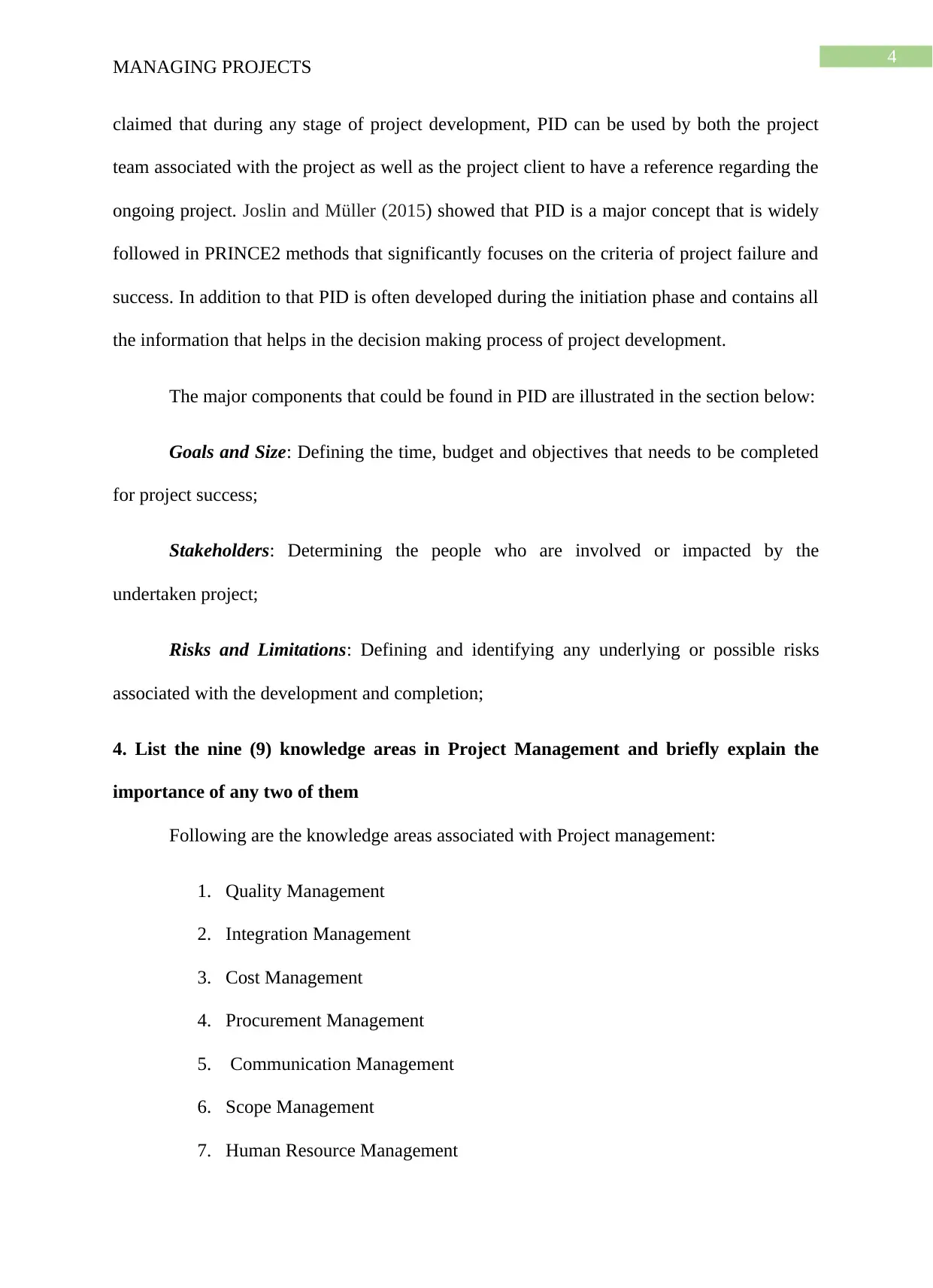
MANAGING PROJECTS
claimed that during any stage of project development, PID can be used by both the project
team associated with the project as well as the project client to have a reference regarding the
ongoing project. Joslin and Müller (2015) showed that PID is a major concept that is widely
followed in PRINCE2 methods that significantly focuses on the criteria of project failure and
success. In addition to that PID is often developed during the initiation phase and contains all
the information that helps in the decision making process of project development.
The major components that could be found in PID are illustrated in the section below:
Goals and Size: Defining the time, budget and objectives that needs to be completed
for project success;
Stakeholders: Determining the people who are involved or impacted by the
undertaken project;
Risks and Limitations: Defining and identifying any underlying or possible risks
associated with the development and completion;
4. List the nine (9) knowledge areas in Project Management and briefly explain the
importance of any two of them
Following are the knowledge areas associated with Project management:
1. Quality Management
2. Integration Management
3. Cost Management
4. Procurement Management
5. Communication Management
6. Scope Management
7. Human Resource Management
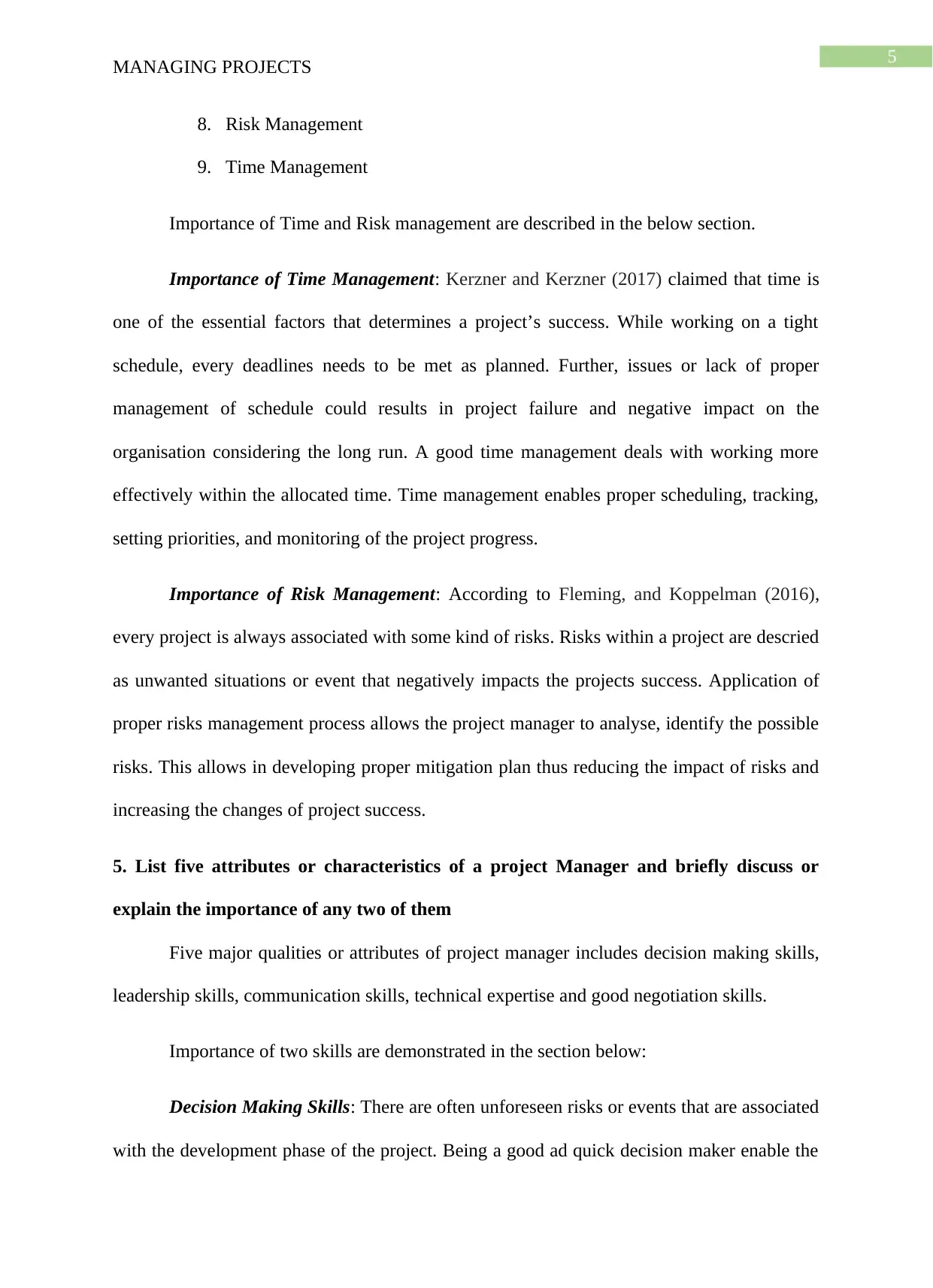
MANAGING PROJECTS
8. Risk Management
9. Time Management
Importance of Time and Risk management are described in the below section.
Importance of Time Management: Kerzner and Kerzner (2017) claimed that time is
one of the essential factors that determines a project’s success. While working on a tight
schedule, every deadlines needs to be met as planned. Further, issues or lack of proper
management of schedule could results in project failure and negative impact on the
organisation considering the long run. A good time management deals with working more
effectively within the allocated time. Time management enables proper scheduling, tracking,
setting priorities, and monitoring of the project progress.
Importance of Risk Management: According to Fleming, and Koppelman (2016),
every project is always associated with some kind of risks. Risks within a project are descried
as unwanted situations or event that negatively impacts the projects success. Application of
proper risks management process allows the project manager to analyse, identify the possible
risks. This allows in developing proper mitigation plan thus reducing the impact of risks and
increasing the changes of project success.
5. List five attributes or characteristics of a project Manager and briefly discuss or
explain the importance of any two of them
Five major qualities or attributes of project manager includes decision making skills,
leadership skills, communication skills, technical expertise and good negotiation skills.
Importance of two skills are demonstrated in the section below:
Decision Making Skills: There are often unforeseen risks or events that are associated
with the development phase of the project. Being a good ad quick decision maker enable the
⊘ This is a preview!⊘
Do you want full access?
Subscribe today to unlock all pages.

Trusted by 1+ million students worldwide
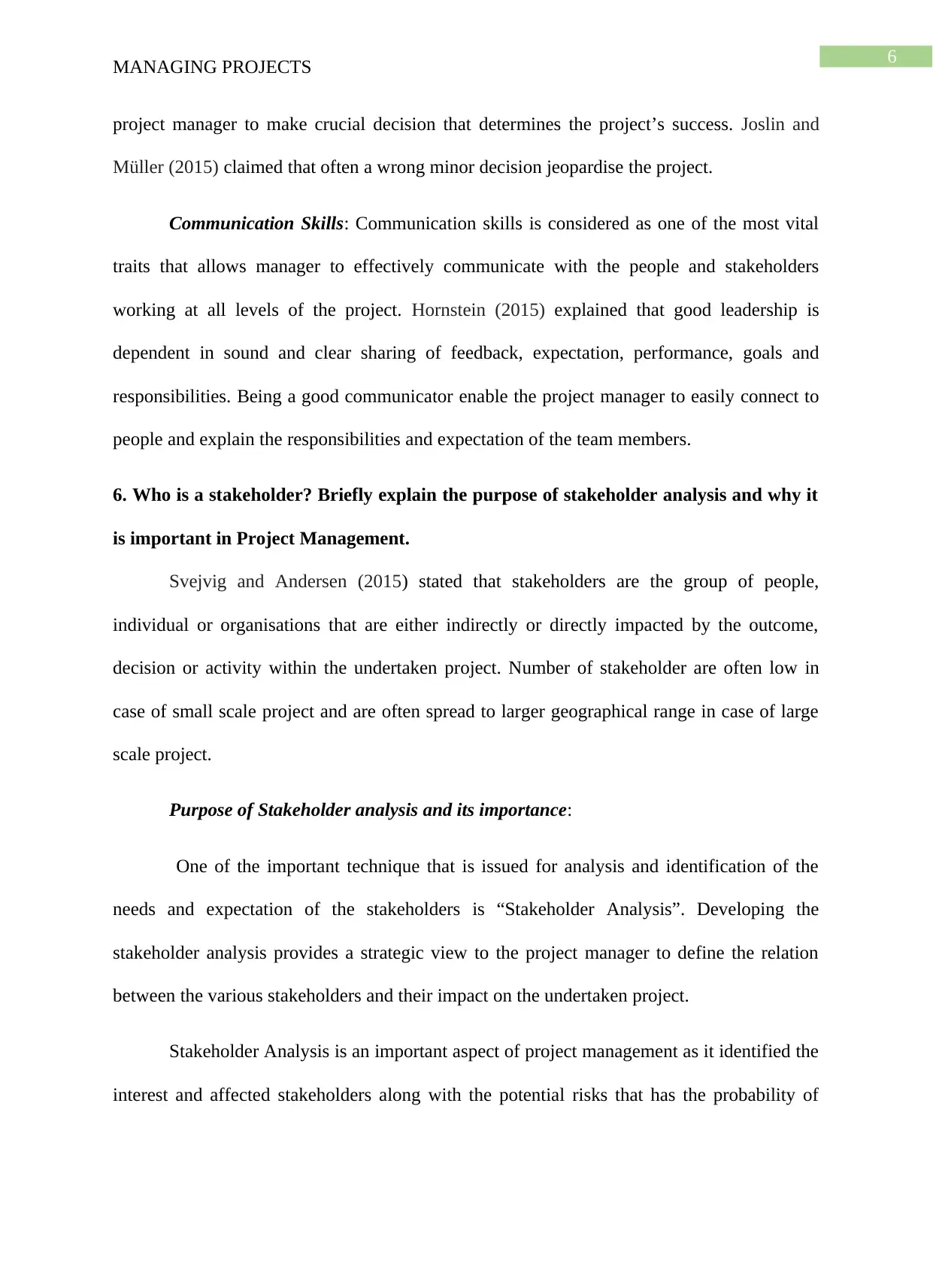
MANAGING PROJECTS
project manager to make crucial decision that determines the project’s success. Joslin and
Müller (2015) claimed that often a wrong minor decision jeopardise the project.
Communication Skills: Communication skills is considered as one of the most vital
traits that allows manager to effectively communicate with the people and stakeholders
working at all levels of the project. Hornstein (2015) explained that good leadership is
dependent in sound and clear sharing of feedback, expectation, performance, goals and
responsibilities. Being a good communicator enable the project manager to easily connect to
people and explain the responsibilities and expectation of the team members.
6. Who is a stakeholder? Briefly explain the purpose of stakeholder analysis and why it
is important in Project Management.
Svejvig and Andersen (2015) stated that stakeholders are the group of people,
individual or organisations that are either indirectly or directly impacted by the outcome,
decision or activity within the undertaken project. Number of stakeholder are often low in
case of small scale project and are often spread to larger geographical range in case of large
scale project.
Purpose of Stakeholder analysis and its importance:
One of the important technique that is issued for analysis and identification of the
needs and expectation of the stakeholders is “Stakeholder Analysis”. Developing the
stakeholder analysis provides a strategic view to the project manager to define the relation
between the various stakeholders and their impact on the undertaken project.
Stakeholder Analysis is an important aspect of project management as it identified the
interest and affected stakeholders along with the potential risks that has the probability of
Paraphrase This Document

MANAGING PROJECTS
disrupting project success. In addition to that, it identified the stakeholders with whom the
information needs to be shared at different stage.
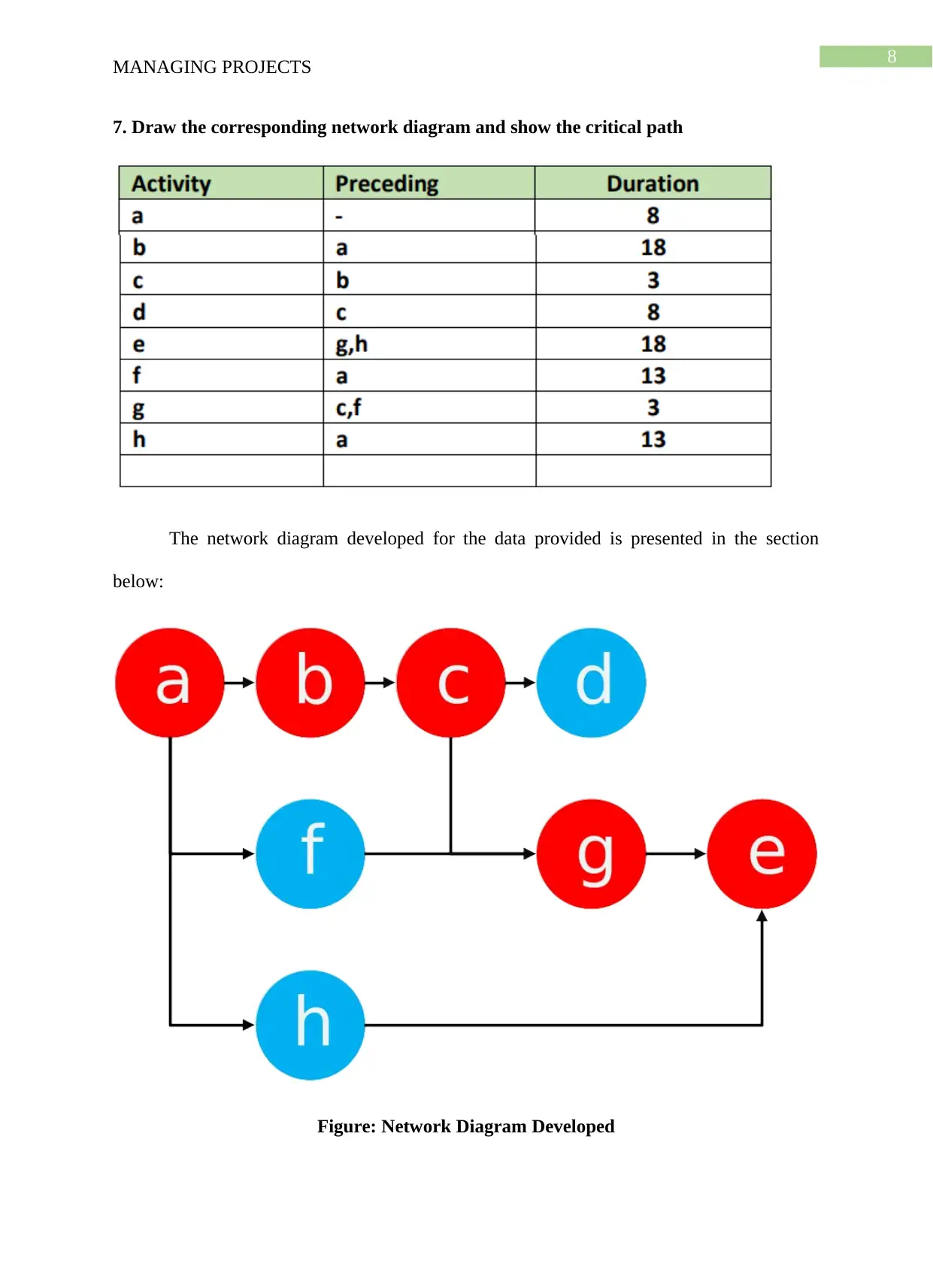
MANAGING PROJECTS
7. Draw the corresponding network diagram and show the critical path
The network diagram developed for the data provided is presented in the section
below:
Figure: Network Diagram Developed
⊘ This is a preview!⊘
Do you want full access?
Subscribe today to unlock all pages.

Trusted by 1+ million students worldwide
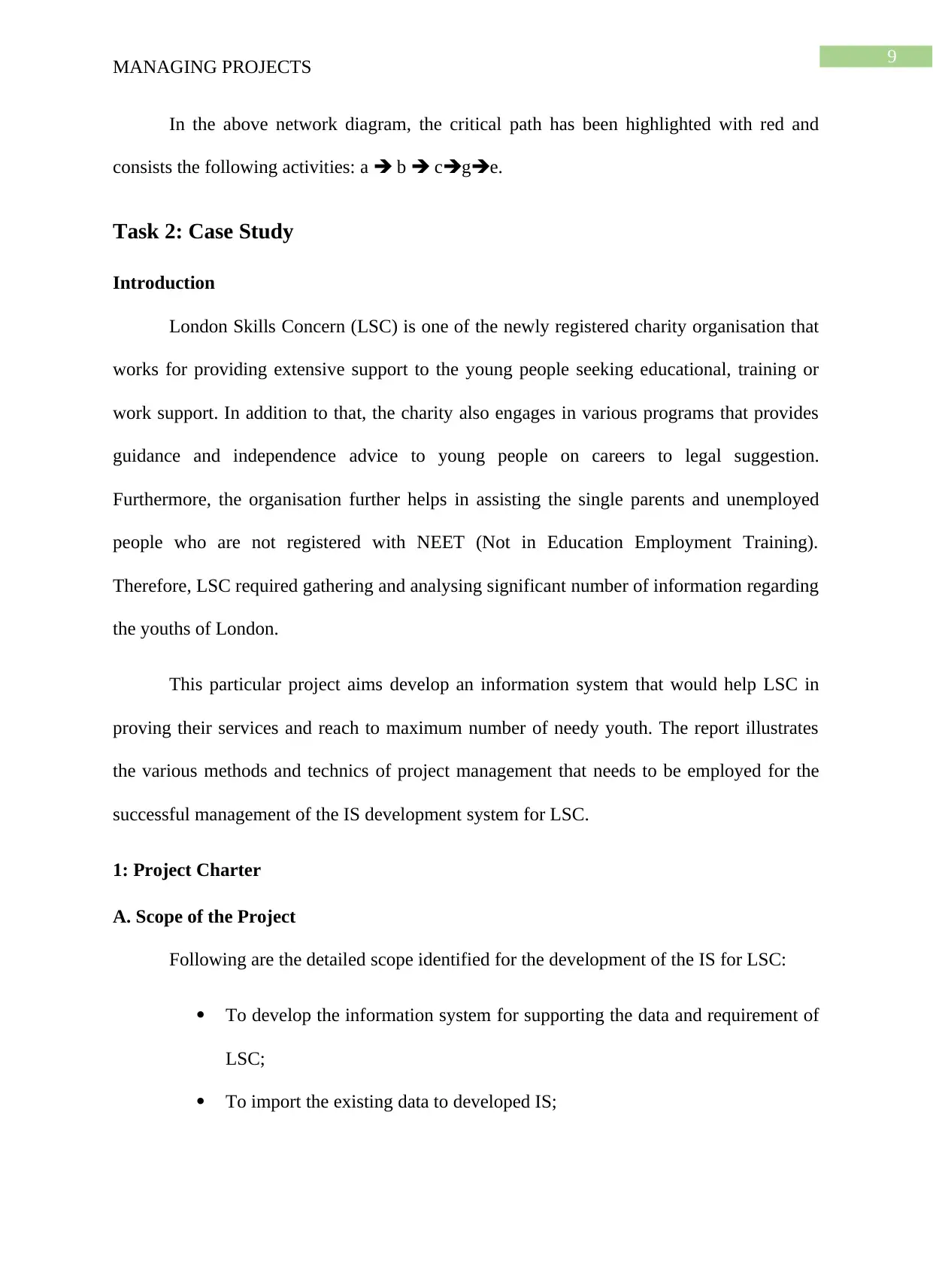
MANAGING PROJECTS
In the above network diagram, the critical path has been highlighted with red and
consists the following activities: a b cge.
Task 2: Case Study
Introduction
London Skills Concern (LSC) is one of the newly registered charity organisation that
works for providing extensive support to the young people seeking educational, training or
work support. In addition to that, the charity also engages in various programs that provides
guidance and independence advice to young people on careers to legal suggestion.
Furthermore, the organisation further helps in assisting the single parents and unemployed
people who are not registered with NEET (Not in Education Employment Training).
Therefore, LSC required gathering and analysing significant number of information regarding
the youths of London.
This particular project aims develop an information system that would help LSC in
proving their services and reach to maximum number of needy youth. The report illustrates
the various methods and technics of project management that needs to be employed for the
successful management of the IS development system for LSC.
1: Project Charter
A. Scope of the Project
Following are the detailed scope identified for the development of the IS for LSC:
To develop the information system for supporting the data and requirement of
LSC;
To import the existing data to developed IS;
Paraphrase This Document
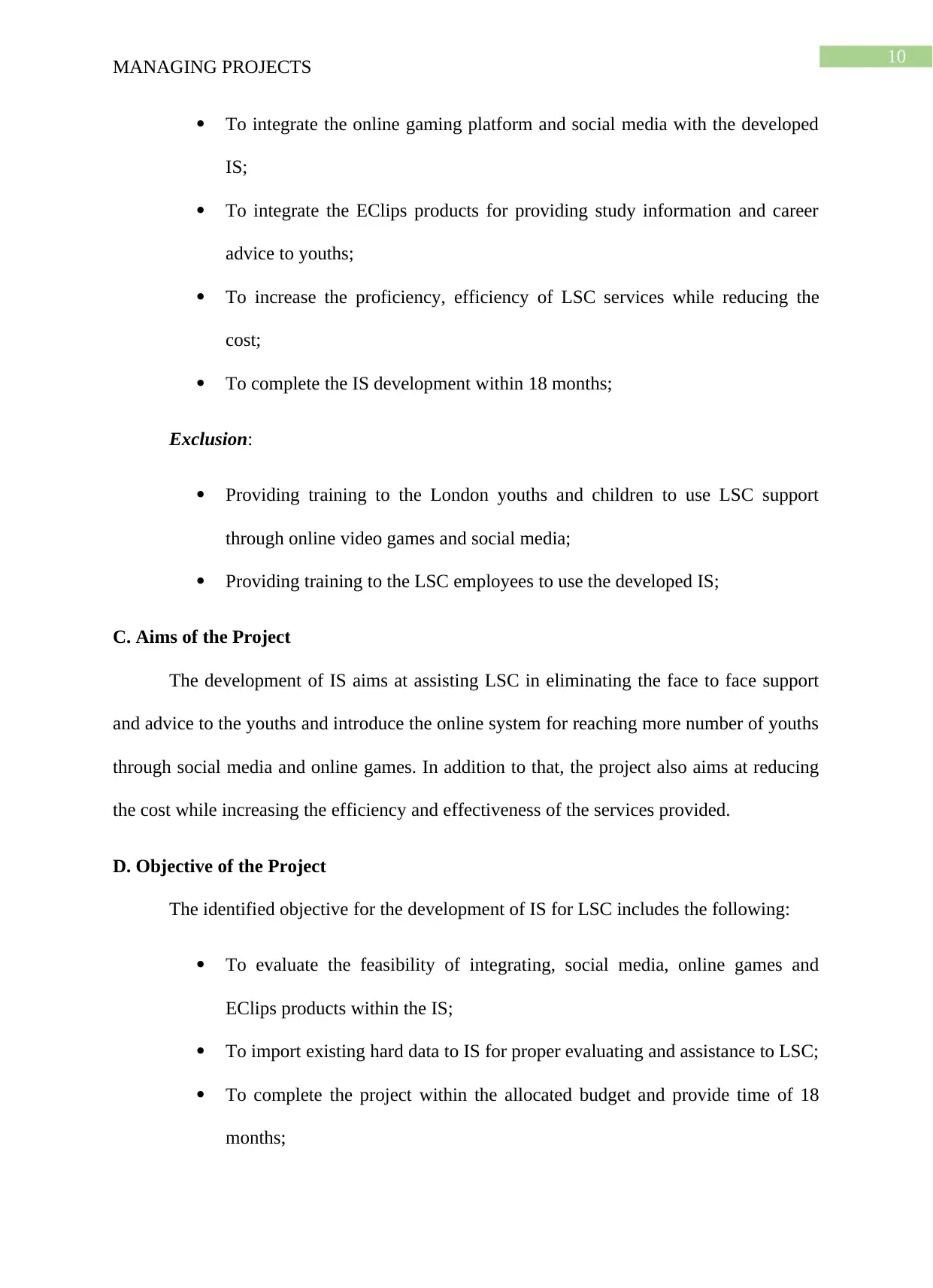
MANAGING PROJECTS
To integrate the online gaming platform and social media with the developed
IS;
To integrate the EClips products for providing study information and career
advice to youths;
To increase the proficiency, efficiency of LSC services while reducing the
cost;
To complete the IS development within 18 months;
Exclusion:
Providing training to the London youths and children to use LSC support
through online video games and social media;
Providing training to the LSC employees to use the developed IS;
C. Aims of the Project
The development of IS aims at assisting LSC in eliminating the face to face support
and advice to the youths and introduce the online system for reaching more number of youths
through social media and online games. In addition to that, the project also aims at reducing
the cost while increasing the efficiency and effectiveness of the services provided.
D. Objective of the Project
The identified objective for the development of IS for LSC includes the following:
To evaluate the feasibility of integrating, social media, online games and
EClips products within the IS;
To import existing hard data to IS for proper evaluating and assistance to LSC;
To complete the project within the allocated budget and provide time of 18
months;
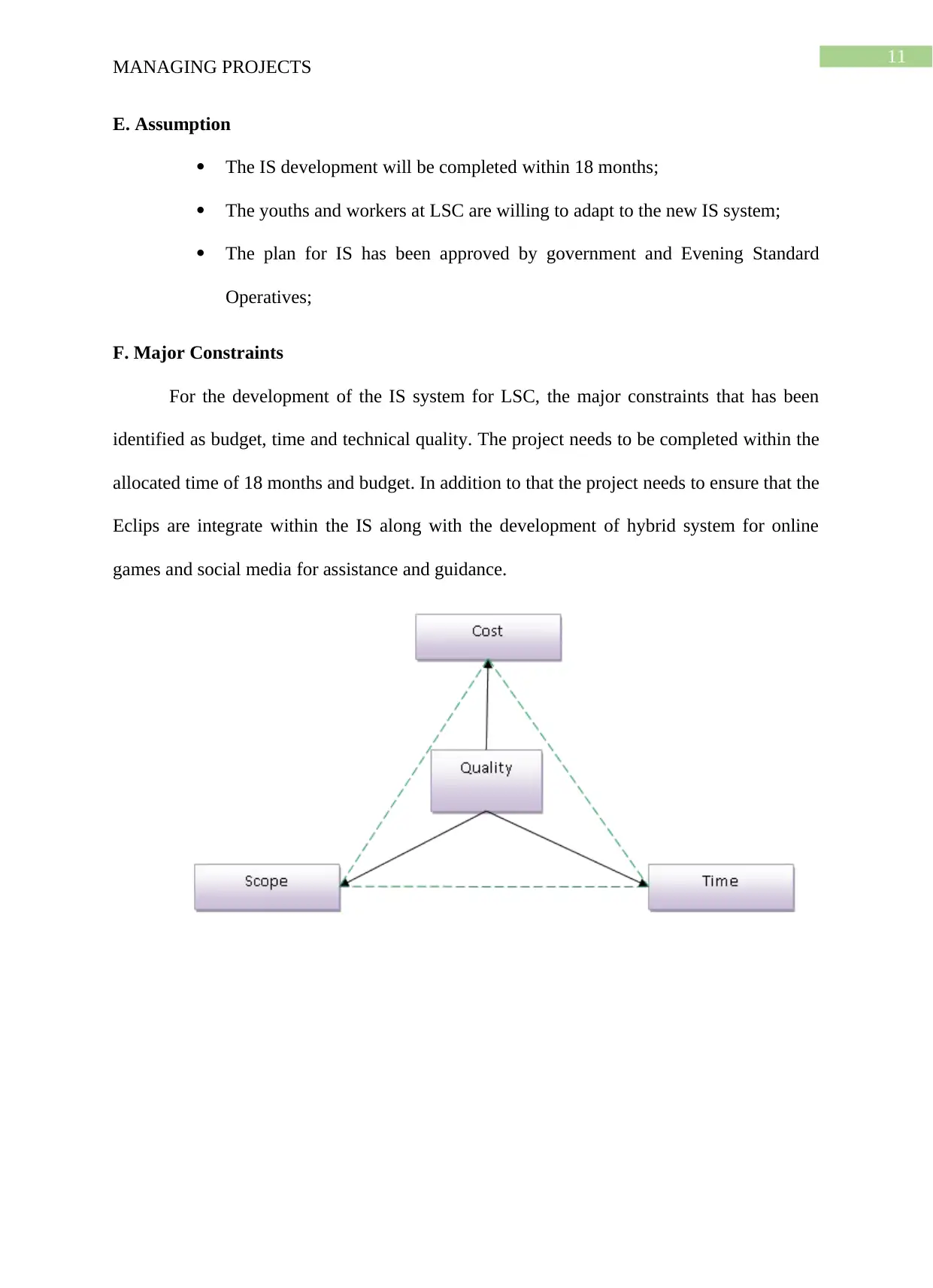
MANAGING PROJECTS
E. Assumption
The IS development will be completed within 18 months;
The youths and workers at LSC are willing to adapt to the new IS system;
The plan for IS has been approved by government and Evening Standard
Operatives;
F. Major Constraints
For the development of the IS system for LSC, the major constraints that has been
identified as budget, time and technical quality. The project needs to be completed within the
allocated time of 18 months and budget. In addition to that the project needs to ensure that the
Eclips are integrate within the IS along with the development of hybrid system for online
games and social media for assistance and guidance.
⊘ This is a preview!⊘
Do you want full access?
Subscribe today to unlock all pages.

Trusted by 1+ million students worldwide
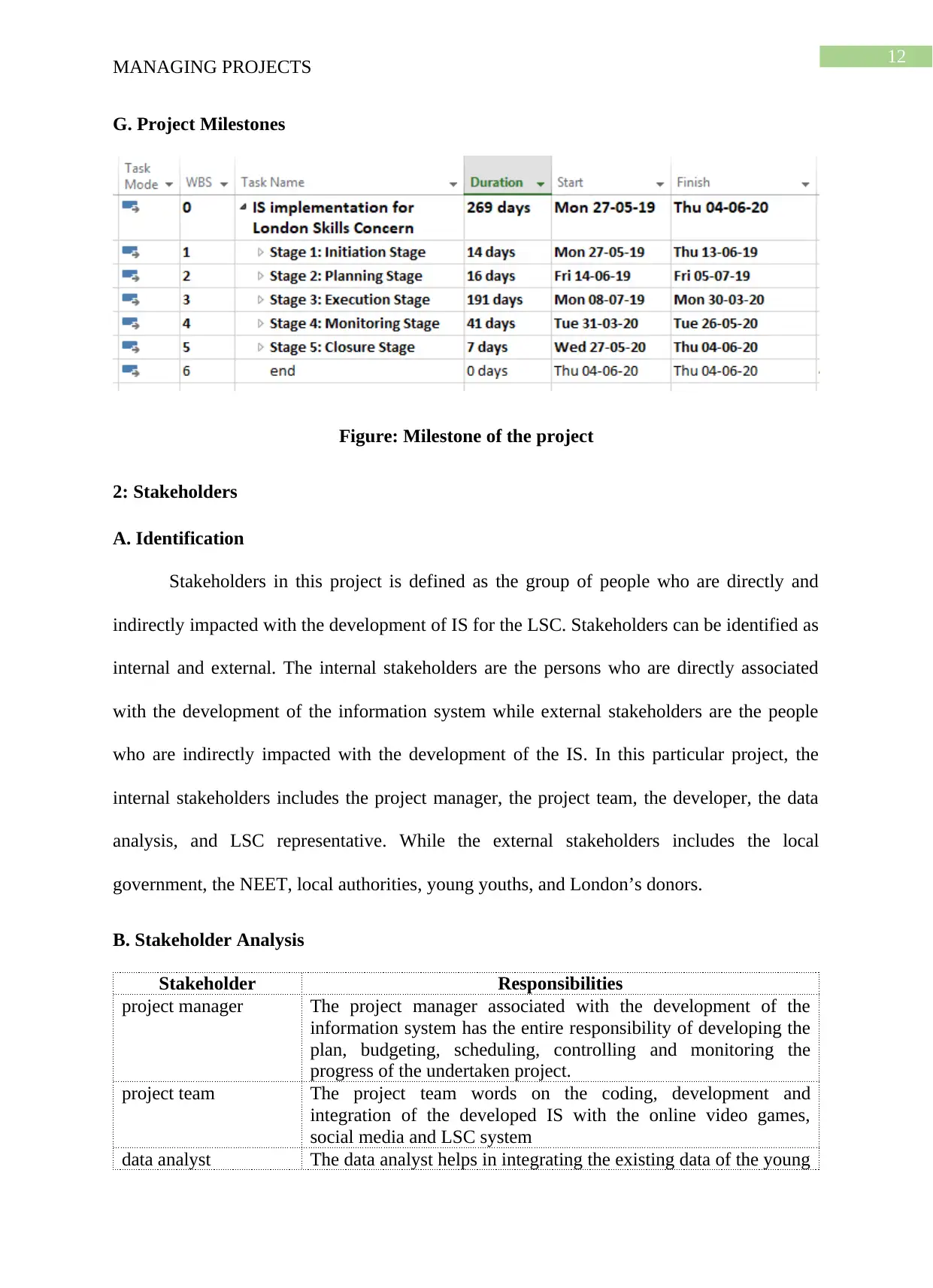
MANAGING PROJECTS
G. Project Milestones
Figure: Milestone of the project
2: Stakeholders
A. Identification
Stakeholders in this project is defined as the group of people who are directly and
indirectly impacted with the development of IS for the LSC. Stakeholders can be identified as
internal and external. The internal stakeholders are the persons who are directly associated
with the development of the information system while external stakeholders are the people
who are indirectly impacted with the development of the IS. In this particular project, the
internal stakeholders includes the project manager, the project team, the developer, the data
analysis, and LSC representative. While the external stakeholders includes the local
government, the NEET, local authorities, young youths, and London’s donors.
B. Stakeholder Analysis
Stakeholder Responsibilities
project manager The project manager associated with the development of the
information system has the entire responsibility of developing the
plan, budgeting, scheduling, controlling and monitoring the
progress of the undertaken project.
project team The project team words on the coding, development and
integration of the developed IS with the online video games,
social media and LSC system
data analyst The data analyst helps in integrating the existing data of the young
Paraphrase This Document
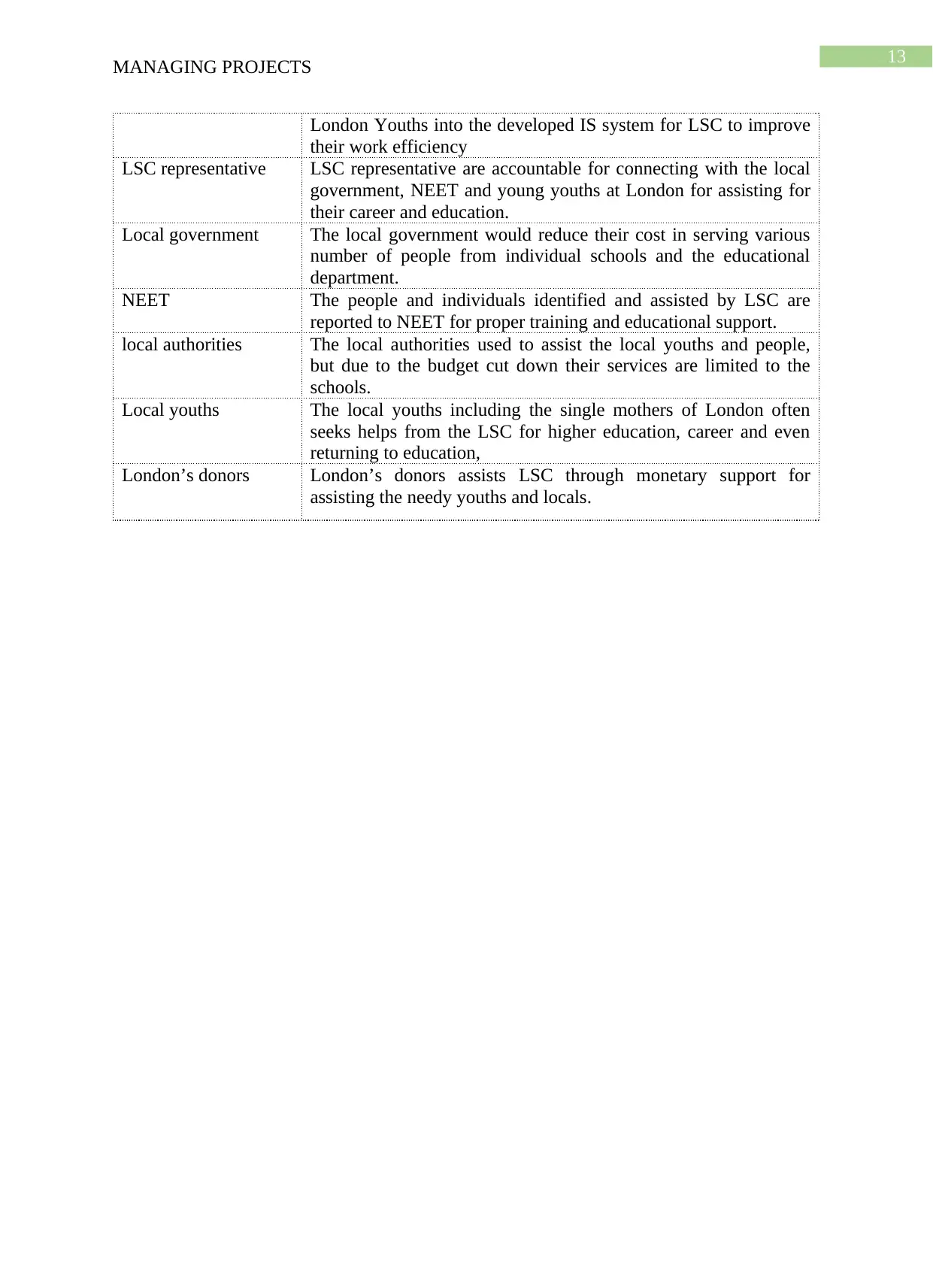
MANAGING PROJECTS
London Youths into the developed IS system for LSC to improve
their work efficiency
LSC representative LSC representative are accountable for connecting with the local
government, NEET and young youths at London for assisting for
their career and education.
Local government The local government would reduce their cost in serving various
number of people from individual schools and the educational
department.
NEET The people and individuals identified and assisted by LSC are
reported to NEET for proper training and educational support.
local authorities The local authorities used to assist the local youths and people,
but due to the budget cut down their services are limited to the
schools.
Local youths The local youths including the single mothers of London often
seeks helps from the LSC for higher education, career and even
returning to education,
London’s donors London’s donors assists LSC through monetary support for
assisting the needy youths and locals.
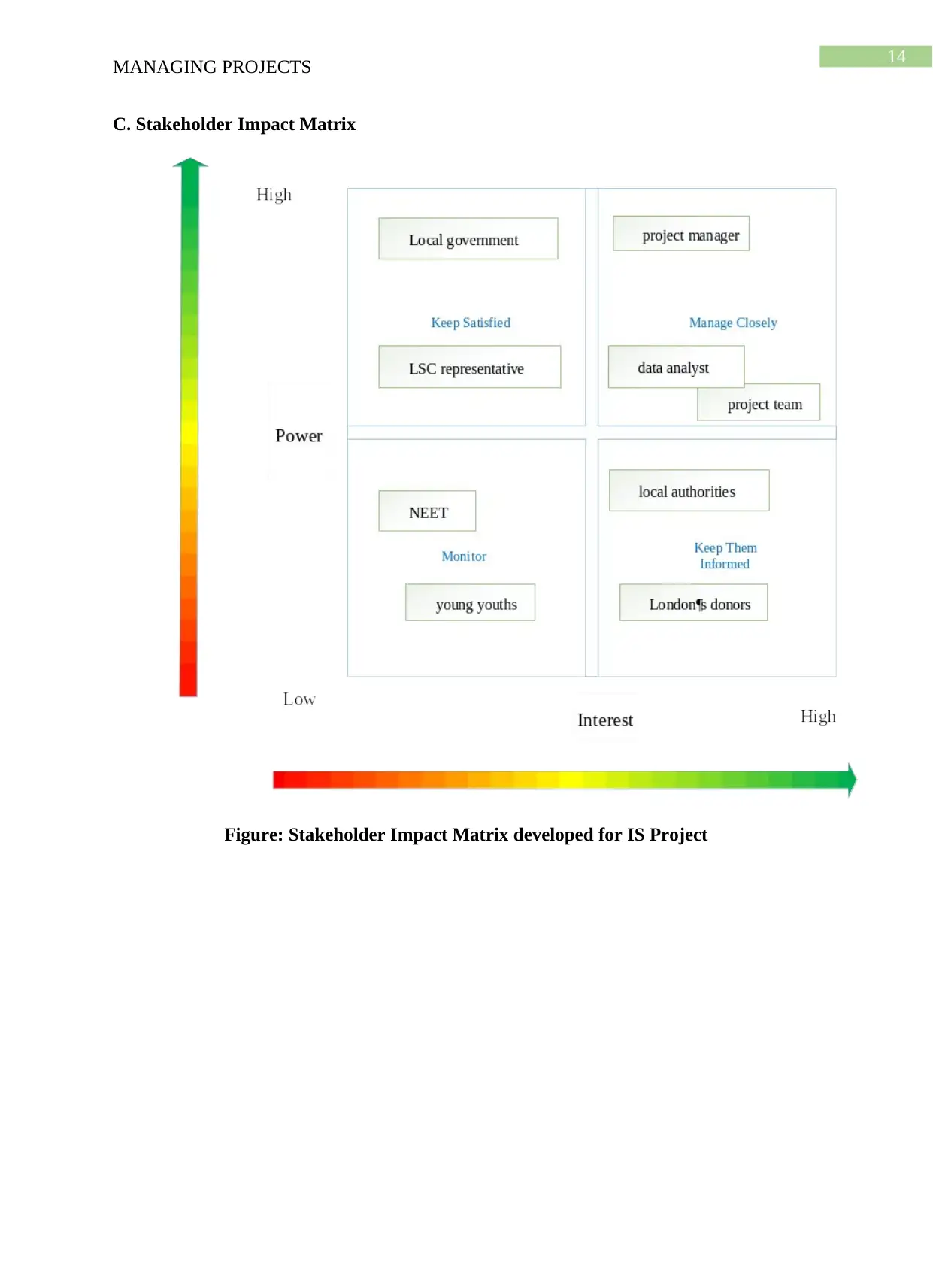
MANAGING PROJECTS
C. Stakeholder Impact Matrix
Figure: Stakeholder Impact Matrix developed for IS Project
⊘ This is a preview!⊘
Do you want full access?
Subscribe today to unlock all pages.

Trusted by 1+ million students worldwide
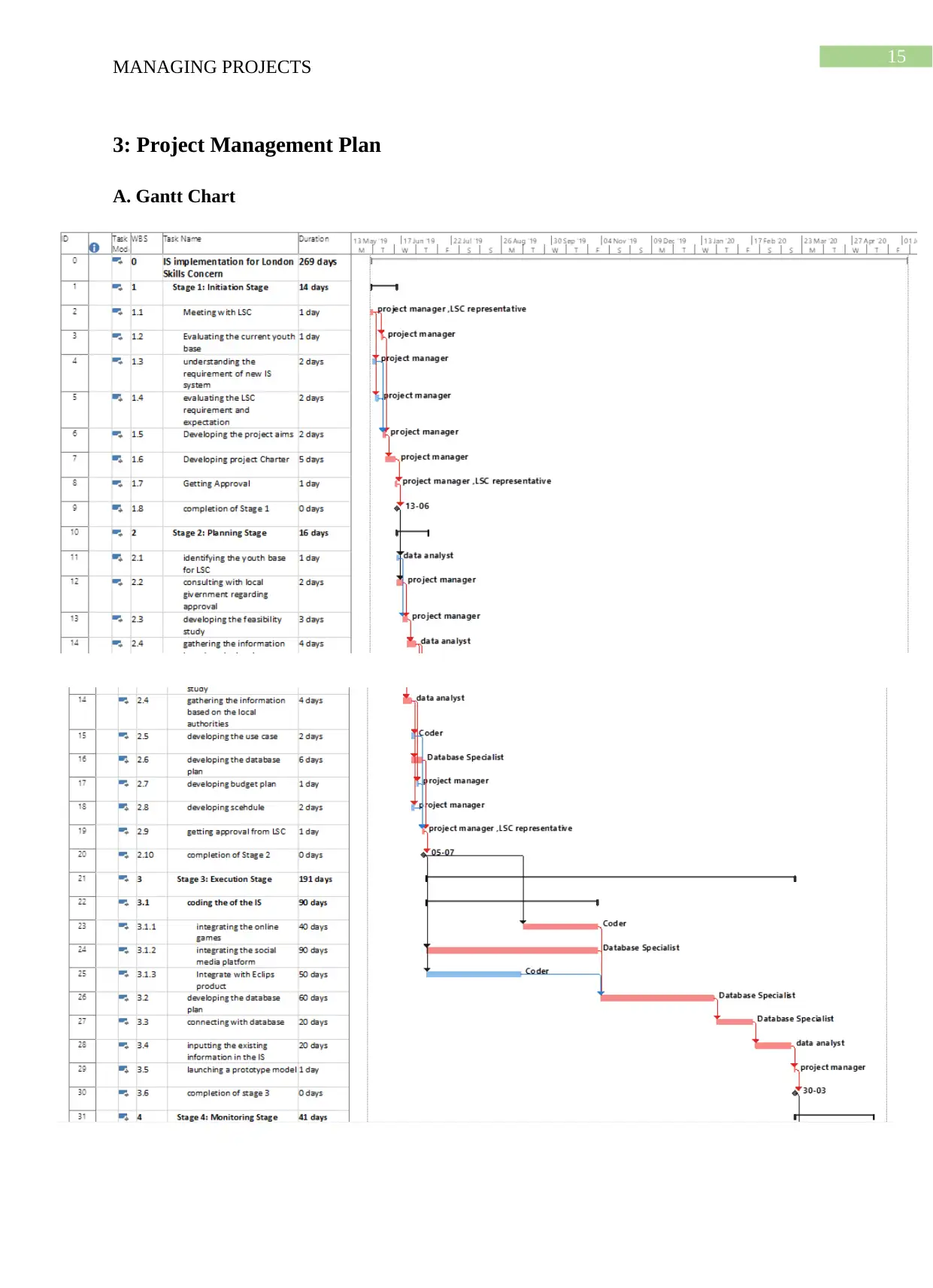
MANAGING PROJECTS
3: Project Management Plan
A. Gantt Chart
Paraphrase This Document
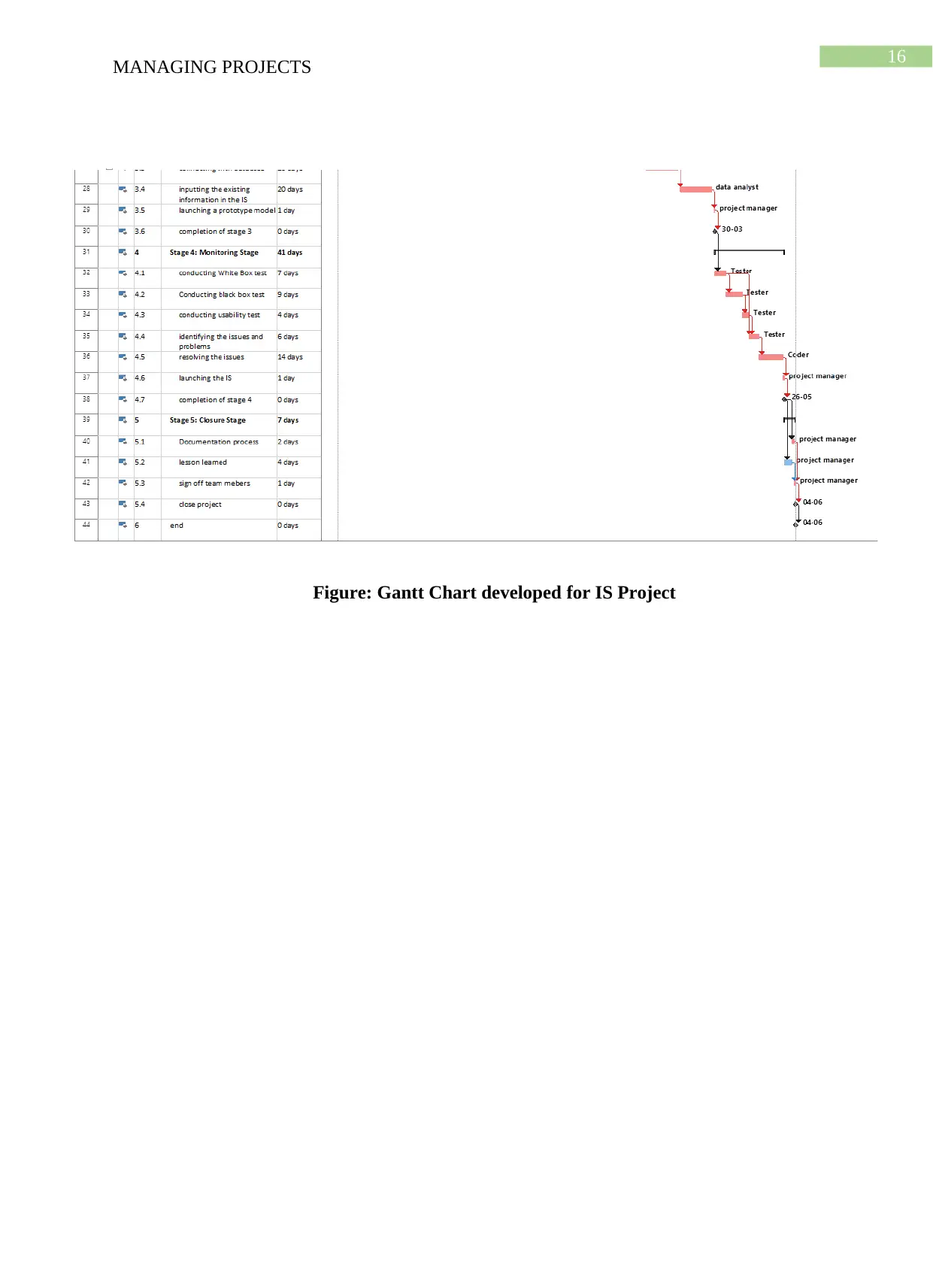
MANAGING PROJECTS
Figure: Gantt Chart developed for IS Project
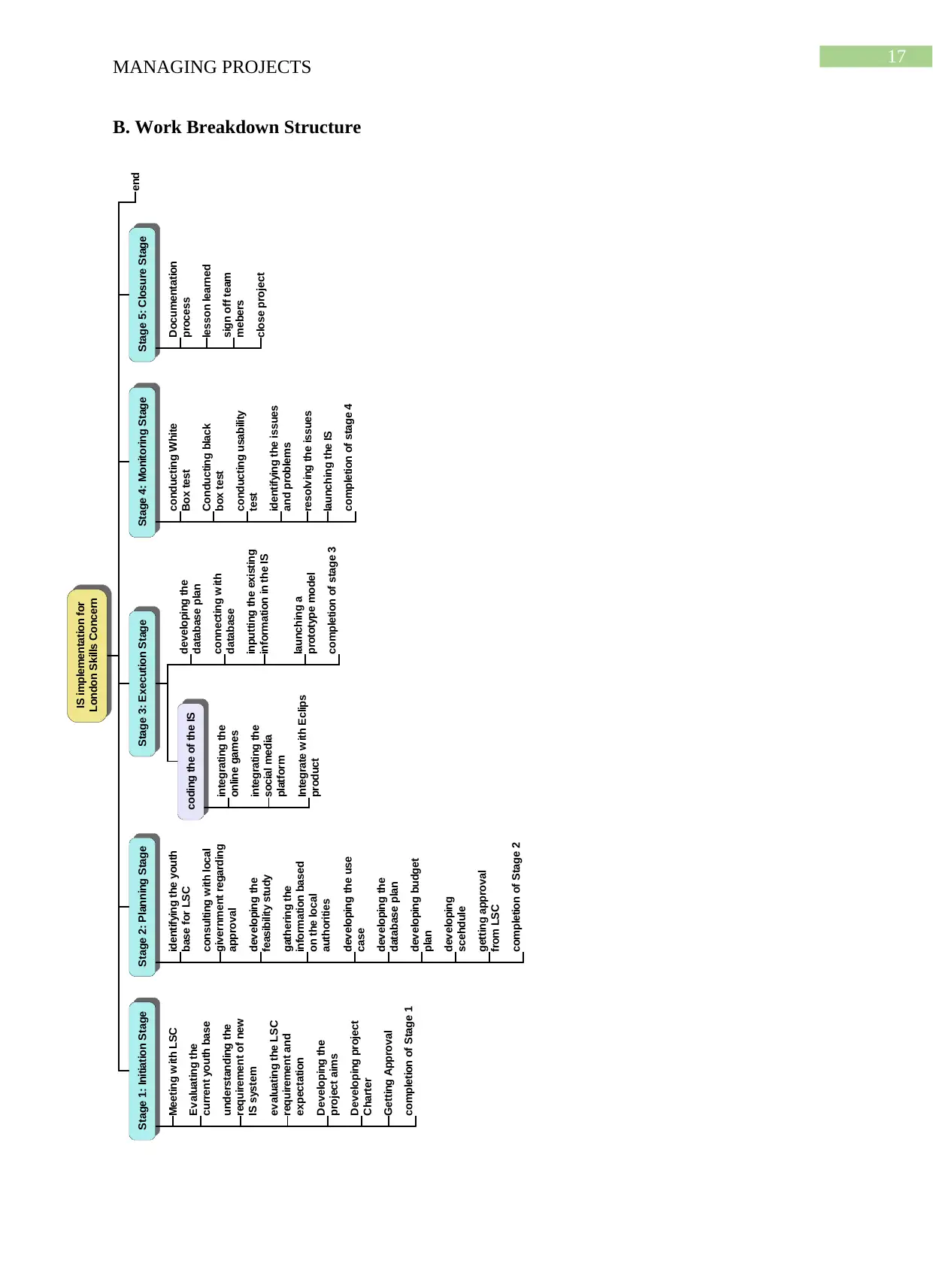
MANAGING PROJECTS
B. Work Breakdown Structure
IS implementation for
London Skills Concern
Stage 1: Initiation Stage
Meeting with LSC
Evaluating the
current youth base
understanding the
requirement of new
IS system
evaluating the LSC
requirement and
expectation
Developing the
project aims
Developing project
Charter
Getting Approval
completion of Stage 1
Stage 2: Planning Stage
identifying the youth
base for LSC
consulting with local
givernment regarding
approval
developing the
feasibility study
gathering the
information based
on the local
authorities
developing the use
case
developing the
database plan
developing budget
plan
developing
scehdule
getting approval
from LSC
completion of Stage 2
Stage 3: Execution Stage
coding the of the IS
integrating the
online games
integrating the
social media
platform
Integrate with Eclips
product
developing the
database plan
connecting with
database
inputting the existing
information in the IS
launching a
prototype model
completion of stage 3
Stage 4: Monitoring Stage
conducting White
Box test
Conducting black
box test
conducting usability
test
identifying the issues
and problems
resolving the issues
launching the IS
completion of stage 4
Stage 5: Closure Stage
Documentation
process
lesson learned
sign off team
mebers
close project
end
⊘ This is a preview!⊘
Do you want full access?
Subscribe today to unlock all pages.

Trusted by 1+ million students worldwide
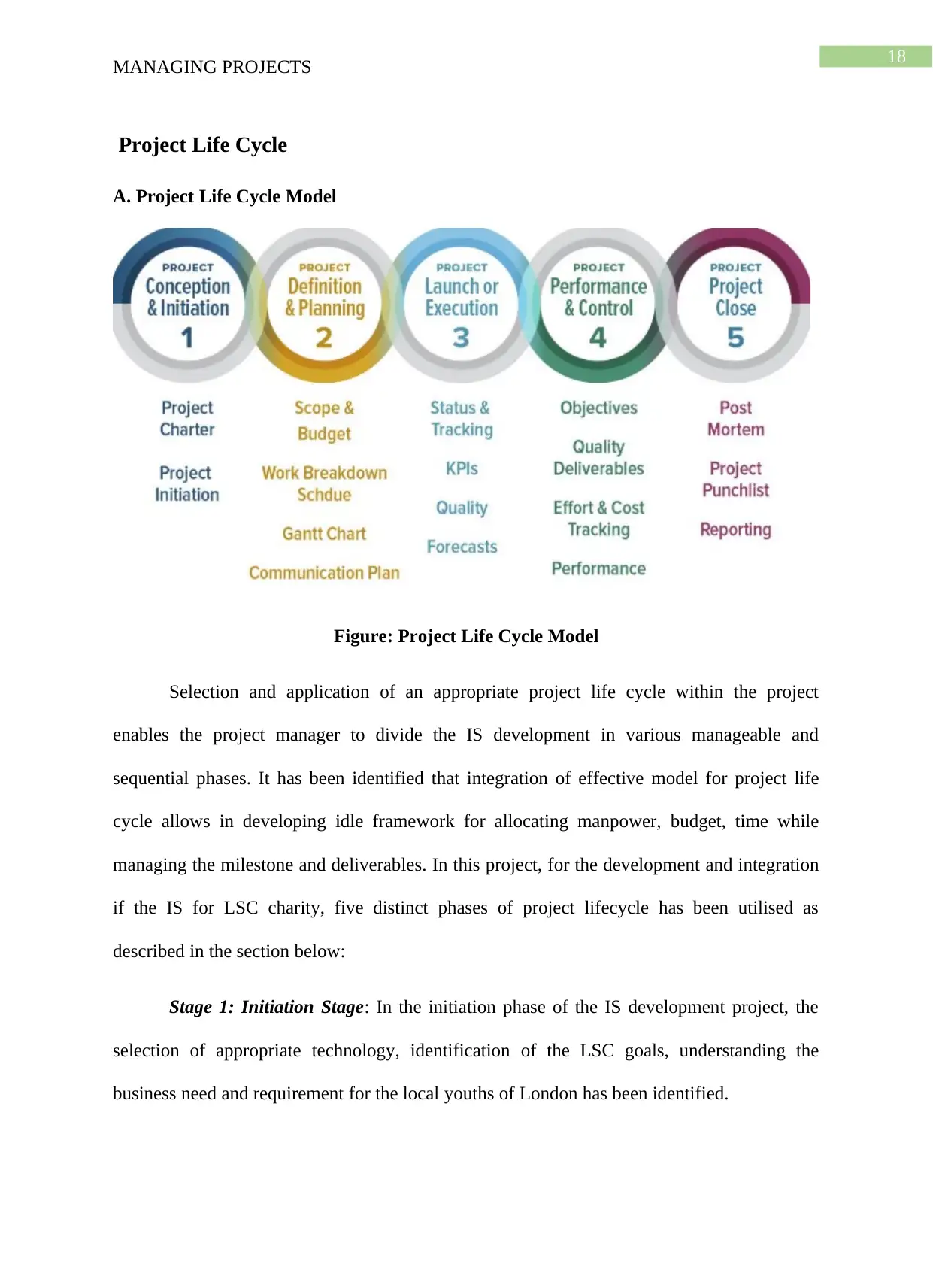
MANAGING PROJECTS
Project Life Cycle
A. Project Life Cycle Model
Figure: Project Life Cycle Model
Selection and application of an appropriate project life cycle within the project
enables the project manager to divide the IS development in various manageable and
sequential phases. It has been identified that integration of effective model for project life
cycle allows in developing idle framework for allocating manpower, budget, time while
managing the milestone and deliverables. In this project, for the development and integration
if the IS for LSC charity, five distinct phases of project lifecycle has been utilised as
described in the section below:
Stage 1: Initiation Stage: In the initiation phase of the IS development project, the
selection of appropriate technology, identification of the LSC goals, understanding the
business need and requirement for the local youths of London has been identified.
Paraphrase This Document
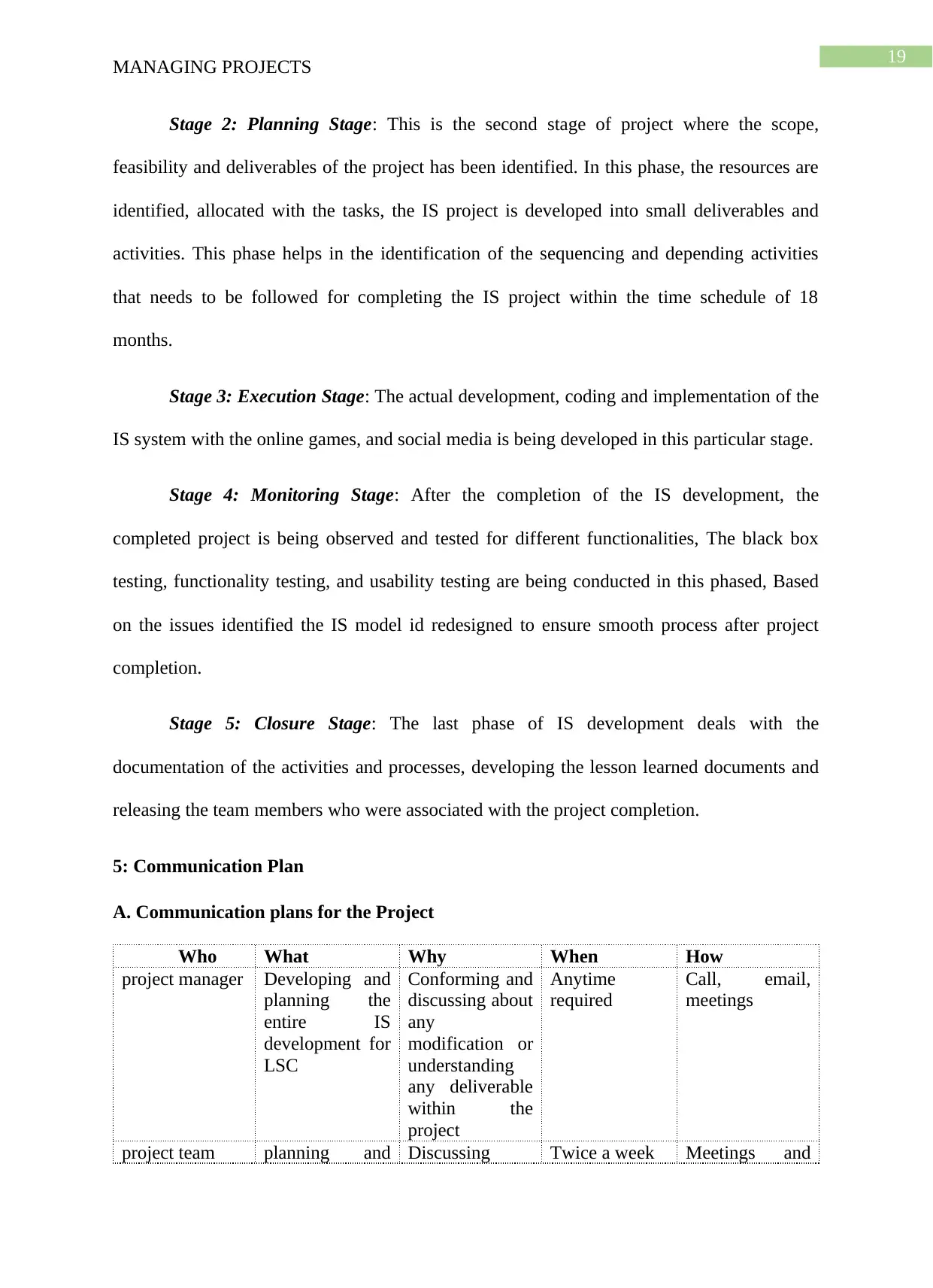
MANAGING PROJECTS
Stage 2: Planning Stage: This is the second stage of project where the scope,
feasibility and deliverables of the project has been identified. In this phase, the resources are
identified, allocated with the tasks, the IS project is developed into small deliverables and
activities. This phase helps in the identification of the sequencing and depending activities
that needs to be followed for completing the IS project within the time schedule of 18
months.
Stage 3: Execution Stage: The actual development, coding and implementation of the
IS system with the online games, and social media is being developed in this particular stage.
Stage 4: Monitoring Stage: After the completion of the IS development, the
completed project is being observed and tested for different functionalities, The black box
testing, functionality testing, and usability testing are being conducted in this phased, Based
on the issues identified the IS model id redesigned to ensure smooth process after project
completion.
Stage 5: Closure Stage: The last phase of IS development deals with the
documentation of the activities and processes, developing the lesson learned documents and
releasing the team members who were associated with the project completion.
5: Communication Plan
A. Communication plans for the Project
Who What Why When How
project manager Developing and
planning the
entire IS
development for
LSC
Conforming and
discussing about
any
modification or
understanding
any deliverable
within the
project
Anytime
required
Call, email,
meetings
project team planning and Discussing Twice a week Meetings and
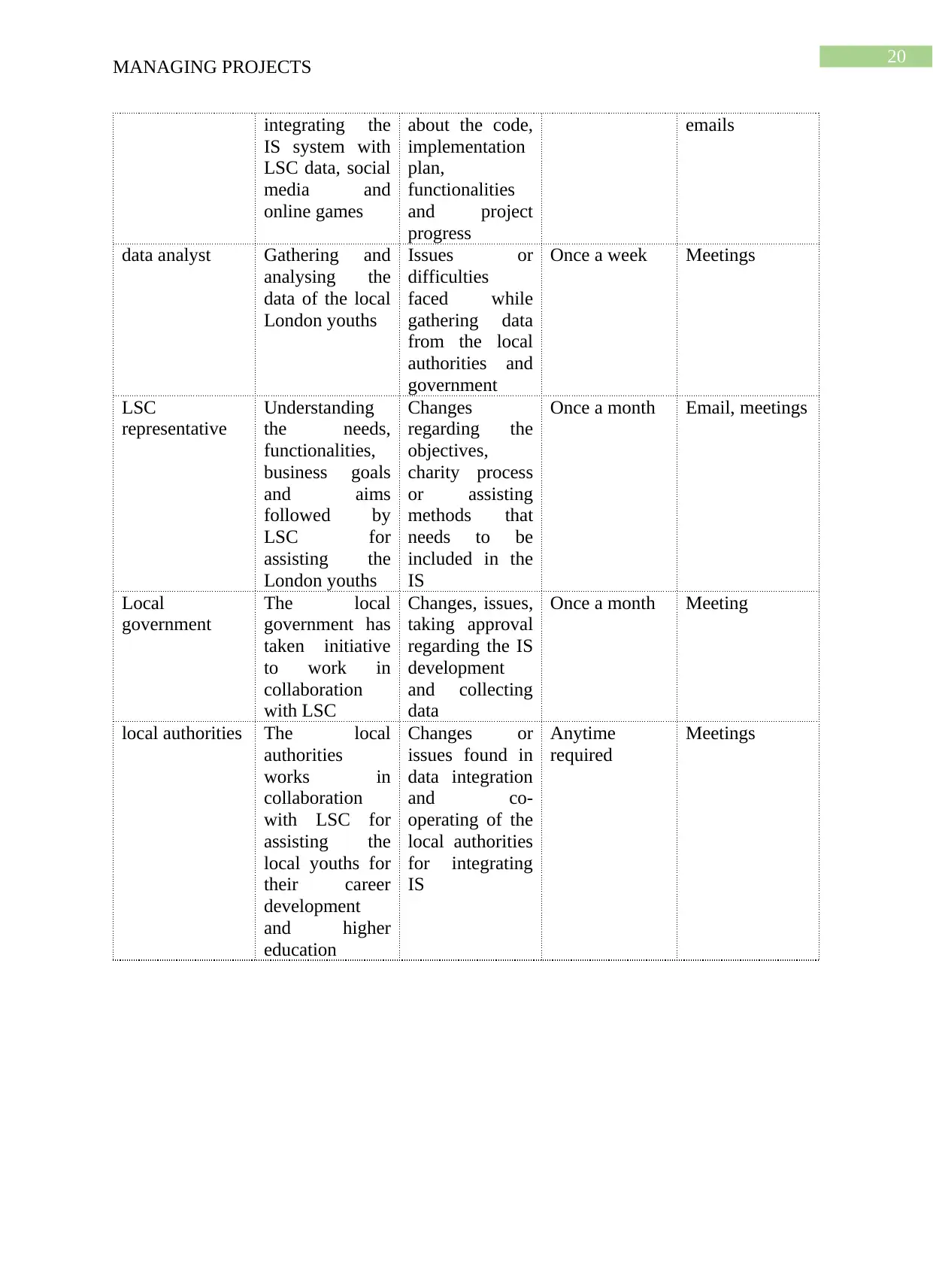
MANAGING PROJECTS
integrating the
IS system with
LSC data, social
media and
online games
about the code,
implementation
plan,
functionalities
and project
progress
emails
data analyst Gathering and
analysing the
data of the local
London youths
Issues or
difficulties
faced while
gathering data
from the local
authorities and
government
Once a week Meetings
LSC
representative
Understanding
the needs,
functionalities,
business goals
and aims
followed by
LSC for
assisting the
London youths
Changes
regarding the
objectives,
charity process
or assisting
methods that
needs to be
included in the
IS
Once a month Email, meetings
Local
government
The local
government has
taken initiative
to work in
collaboration
with LSC
Changes, issues,
taking approval
regarding the IS
development
and collecting
data
Once a month Meeting
local authorities The local
authorities
works in
collaboration
with LSC for
assisting the
local youths for
their career
development
and higher
education
Changes or
issues found in
data integration
and co-
operating of the
local authorities
for integrating
IS
Anytime
required
Meetings
⊘ This is a preview!⊘
Do you want full access?
Subscribe today to unlock all pages.

Trusted by 1+ million students worldwide
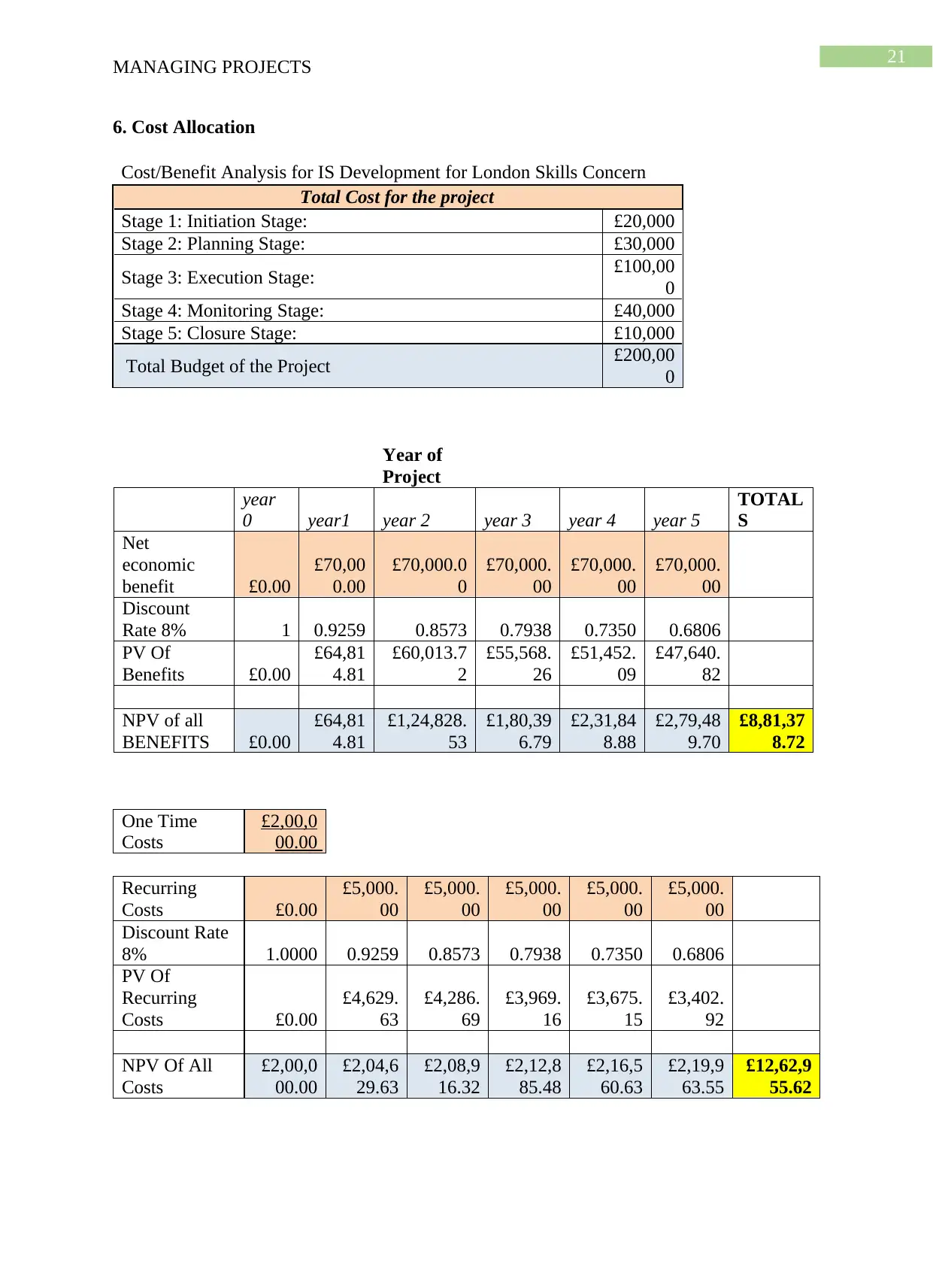
MANAGING PROJECTS
6. Cost Allocation
Cost/Benefit Analysis for IS Development for London Skills Concern
Total Cost for the project
Stage 1: Initiation Stage: £20,000
Stage 2: Planning Stage: £30,000
Stage 3: Execution Stage: £100,00
0
Stage 4: Monitoring Stage: £40,000
Stage 5: Closure Stage: £10,000
Total Budget of the Project £200,00
0
Year of
Project
year
0 year1 year 2 year 3 year 4 year 5
TOTAL
S
Net
economic
benefit £0.00
£70,00
0.00
£70,000.0
0
£70,000.
00
£70,000.
00
£70,000.
00
Discount
Rate 8% 1 0.9259 0.8573 0.7938 0.7350 0.6806
PV Of
Benefits £0.00
£64,81
4.81
£60,013.7
2
£55,568.
26
£51,452.
09
£47,640.
82
NPV of all
BENEFITS £0.00
£64,81
4.81
£1,24,828.
53
£1,80,39
6.79
£2,31,84
8.88
£2,79,48
9.70
£8,81,37
8.72
One Time
Costs
£2,00,0
00.00
Recurring
Costs £0.00
£5,000.
00
£5,000.
00
£5,000.
00
£5,000.
00
£5,000.
00
Discount Rate
8% 1.0000 0.9259 0.8573 0.7938 0.7350 0.6806
PV Of
Recurring
Costs £0.00
£4,629.
63
£4,286.
69
£3,969.
16
£3,675.
15
£3,402.
92
NPV Of All
Costs
£2,00,0
00.00
£2,04,6
29.63
£2,08,9
16.32
£2,12,8
85.48
£2,16,5
60.63
£2,19,9
63.55
£12,62,9
55.62
Paraphrase This Document
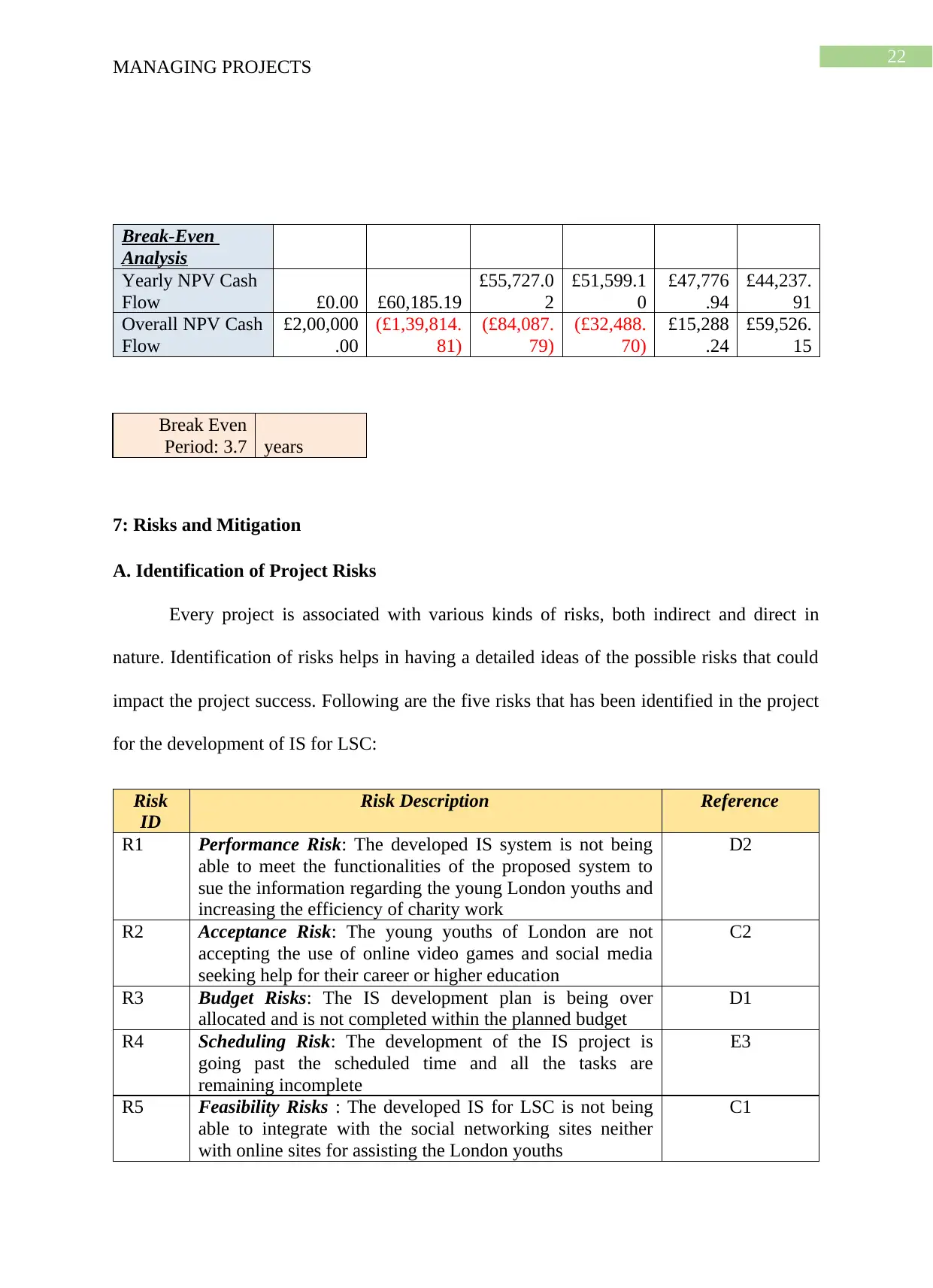
MANAGING PROJECTS
Break-Even
Analysis
Yearly NPV Cash
Flow £0.00 £60,185.19
£55,727.0
2
£51,599.1
0
£47,776
.94
£44,237.
91
Overall NPV Cash
Flow
£2,00,000
.00
(£1,39,814.
81)
(£84,087.
79)
(£32,488.
70)
£15,288
.24
£59,526.
15
Break Even
Period: 3.7 years
7: Risks and Mitigation
A. Identification of Project Risks
Every project is associated with various kinds of risks, both indirect and direct in
nature. Identification of risks helps in having a detailed ideas of the possible risks that could
impact the project success. Following are the five risks that has been identified in the project
for the development of IS for LSC:
Risk
ID
Risk Description Reference
R1 Performance Risk: The developed IS system is not being
able to meet the functionalities of the proposed system to
sue the information regarding the young London youths and
increasing the efficiency of charity work
D2
R2 Acceptance Risk: The young youths of London are not
accepting the use of online video games and social media
seeking help for their career or higher education
C2
R3 Budget Risks: The IS development plan is being over
allocated and is not completed within the planned budget
D1
R4 Scheduling Risk: The development of the IS project is
going past the scheduled time and all the tasks are
remaining incomplete
E3
R5 Feasibility Risks : The developed IS for LSC is not being
able to integrate with the social networking sites neither
with online sites for assisting the London youths
C1
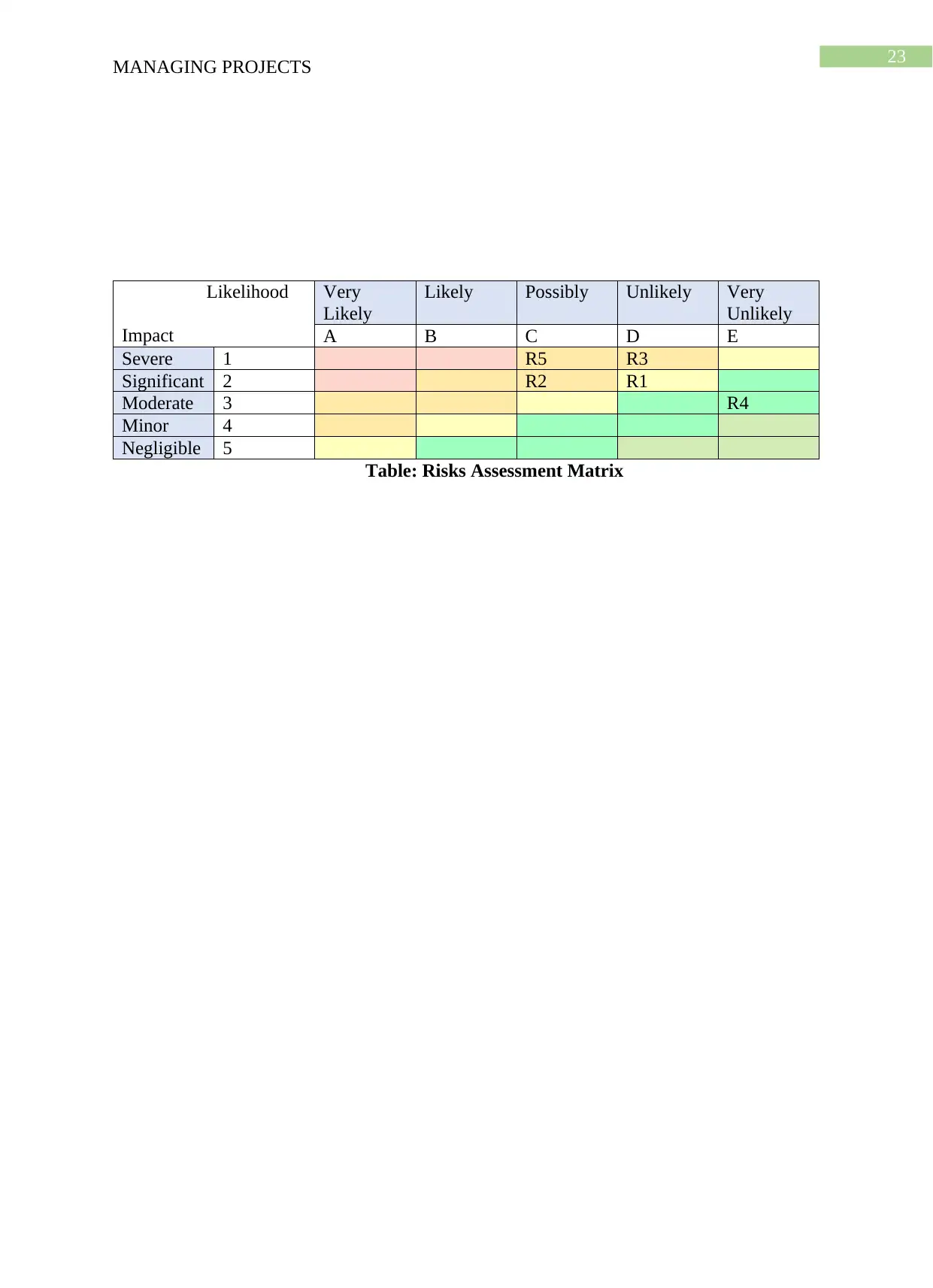
MANAGING PROJECTS
Likelihood
Impact
Very
Likely
Likely Possibly Unlikely Very
Unlikely
A B C D E
Severe 1 R5 R3
Significant 2 R2 R1
Moderate 3 R4
Minor 4
Negligible 5
Table: Risks Assessment Matrix
⊘ This is a preview!⊘
Do you want full access?
Subscribe today to unlock all pages.

Trusted by 1+ million students worldwide
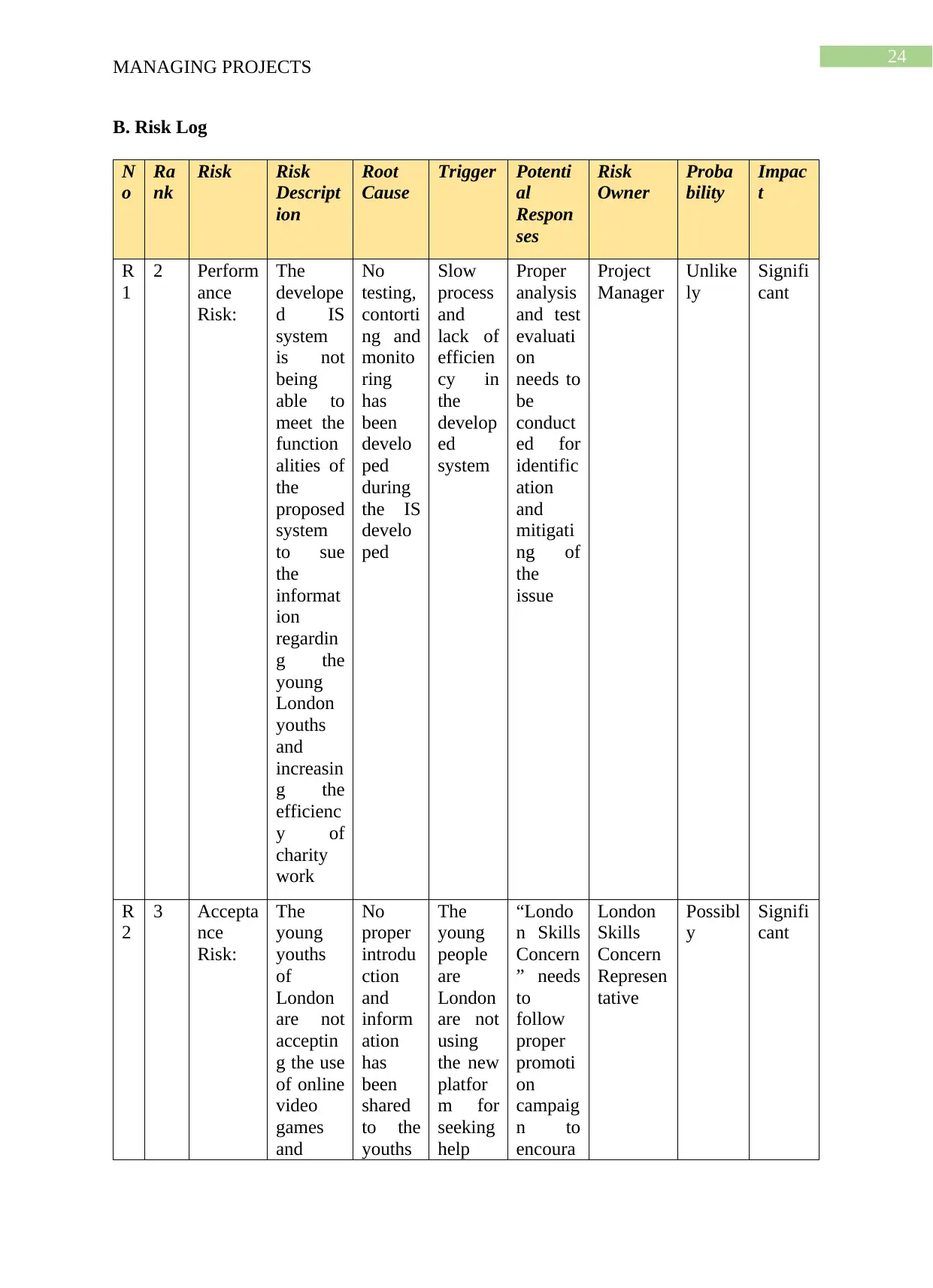
MANAGING PROJECTS
B. Risk Log
N
o
Ra
nk
Risk Risk
Descript
ion
Root
Cause
Trigger Potenti
al
Respon
ses
Risk
Owner
Proba
bility
Impac
t
R
1
2 Perform
ance
Risk:
The
develope
d IS
system
is not
being
able to
meet the
function
alities of
the
proposed
system
to sue
the
informat
ion
regardin
g the
young
London
youths
and
increasin
g the
efficienc
y of
charity
work
No
testing,
contorti
ng and
monito
ring
has
been
develo
ped
during
the IS
develo
ped
Slow
process
and
lack of
efficien
cy in
the
develop
ed
system
Proper
analysis
and test
evaluati
on
needs to
be
conduct
ed for
identific
ation
and
mitigati
ng of
the
issue
Project
Manager
Unlike
ly
Signifi
cant
R
2
3 Accepta
nce
Risk:
The
young
youths
of
London
are not
acceptin
g the use
of online
video
games
and
No
proper
introdu
ction
and
inform
ation
has
been
shared
to the
youths
The
young
people
are
London
are not
using
the new
platfor
m for
seeking
help
“Londo
n Skills
Concern
” needs
to
follow
proper
promoti
on
campaig
n to
encoura
London
Skills
Concern
Represen
tative
Possibl
y
Signifi
cant
Paraphrase This Document
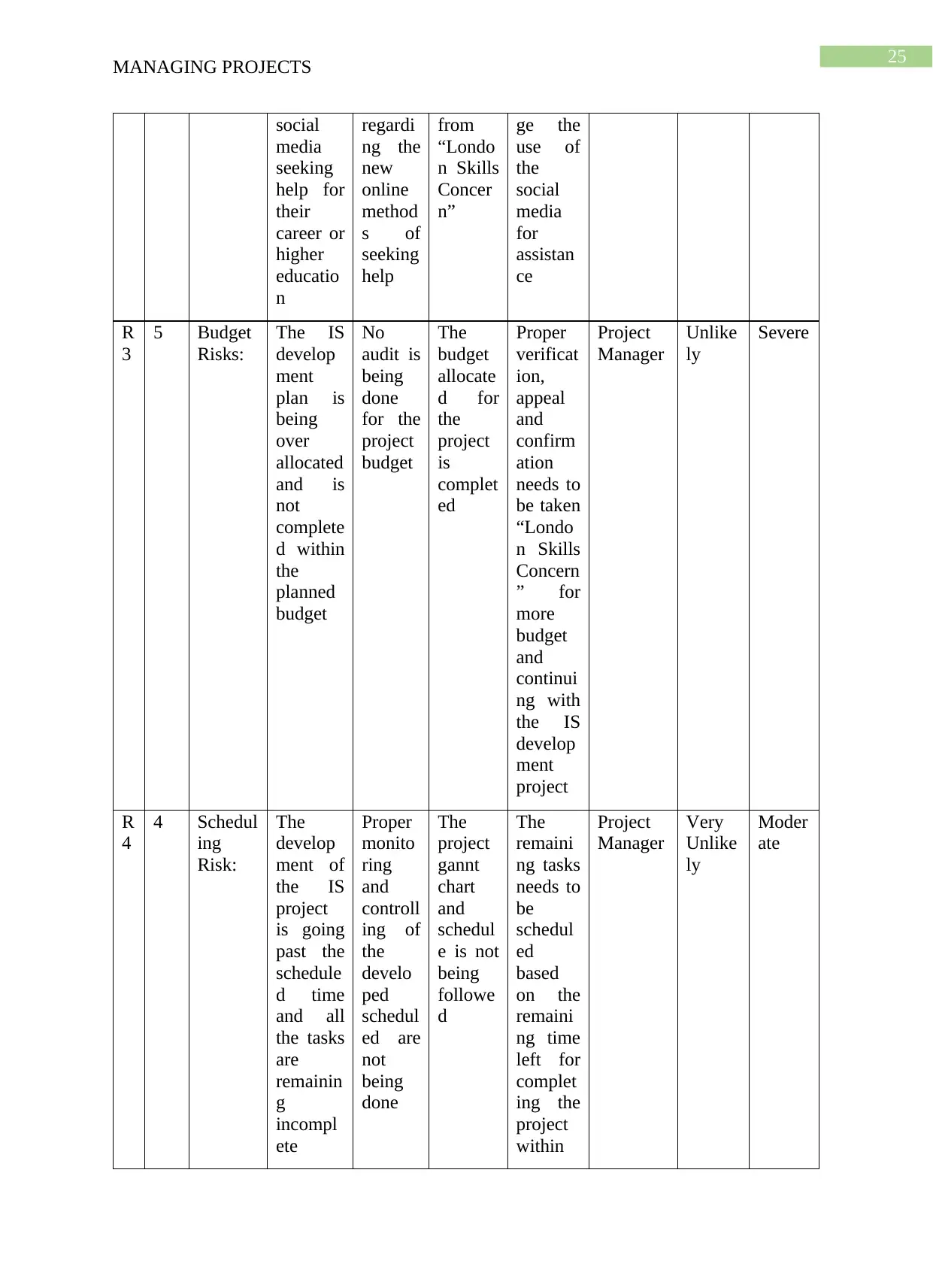
MANAGING PROJECTS
social
media
seeking
help for
their
career or
higher
educatio
n
regardi
ng the
new
online
method
s of
seeking
help
from
“Londo
n Skills
Concer
n”
ge the
use of
the
social
media
for
assistan
ce
R
3
5 Budget
Risks:
The IS
develop
ment
plan is
being
over
allocated
and is
not
complete
d within
the
planned
budget
No
audit is
being
done
for the
project
budget
The
budget
allocate
d for
the
project
is
complet
ed
Proper
verificat
ion,
appeal
and
confirm
ation
needs to
be taken
“Londo
n Skills
Concern
” for
more
budget
and
continui
ng with
the IS
develop
ment
project
Project
Manager
Unlike
ly
Severe
R
4
4 Schedul
ing
Risk:
The
develop
ment of
the IS
project
is going
past the
schedule
d time
and all
the tasks
are
remainin
g
incompl
ete
Proper
monito
ring
and
controll
ing of
the
develo
ped
schedul
ed are
not
being
done
The
project
gannt
chart
and
schedul
e is not
being
followe
d
The
remaini
ng tasks
needs to
be
schedul
ed
based
on the
remaini
ng time
left for
complet
ing the
project
within
Project
Manager
Very
Unlike
ly
Moder
ate
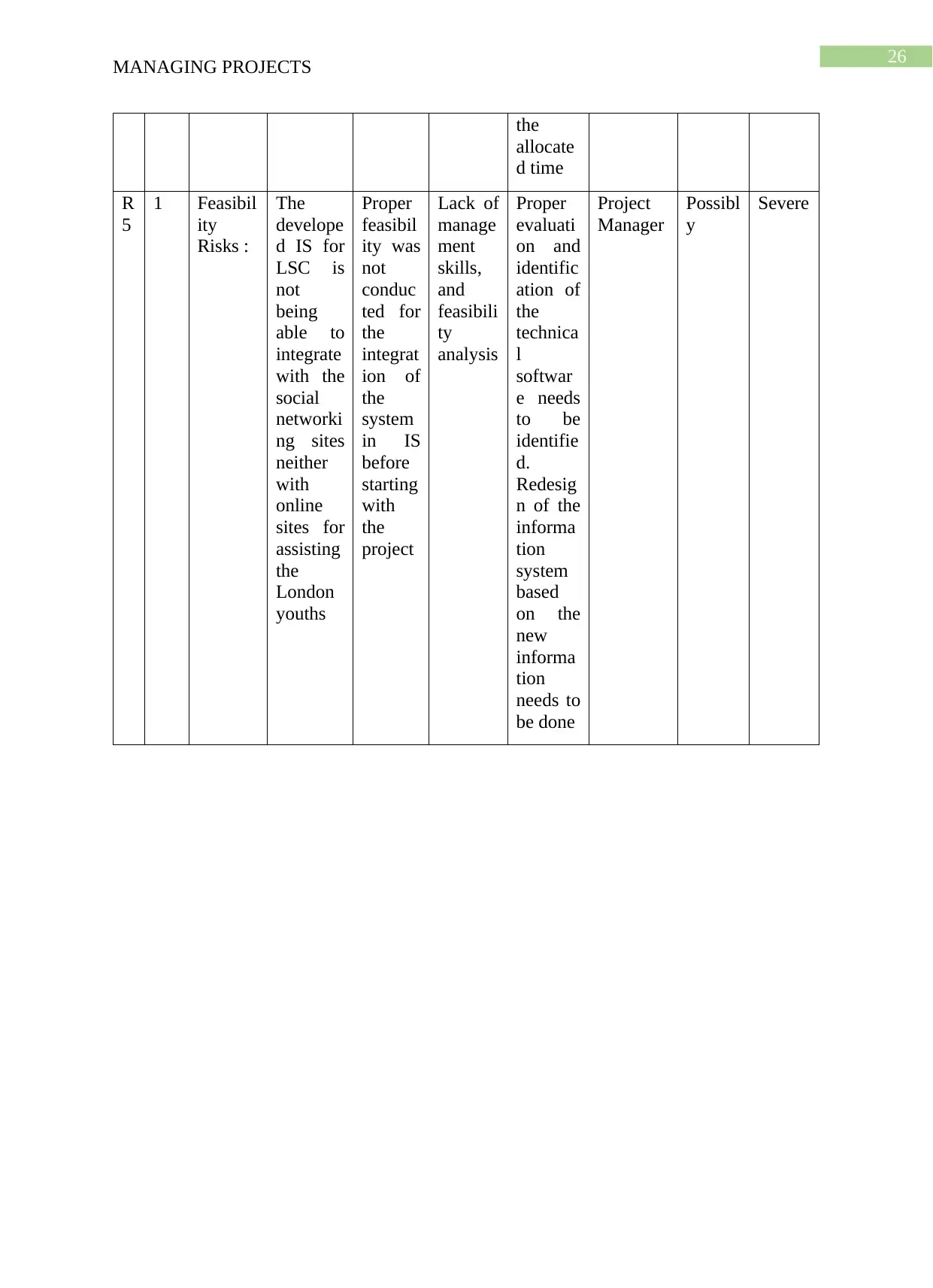
MANAGING PROJECTS
the
allocate
d time
R
5
1 Feasibil
ity
Risks :
The
develope
d IS for
LSC is
not
being
able to
integrate
with the
social
networki
ng sites
neither
with
online
sites for
assisting
the
London
youths
Proper
feasibil
ity was
not
conduc
ted for
the
integrat
ion of
the
system
in IS
before
starting
with
the
project
Lack of
manage
ment
skills,
and
feasibili
ty
analysis
Proper
evaluati
on and
identific
ation of
the
technica
l
softwar
e needs
to be
identifie
d.
Redesig
n of the
informa
tion
system
based
on the
new
informa
tion
needs to
be done
Project
Manager
Possibl
y
Severe
⊘ This is a preview!⊘
Do you want full access?
Subscribe today to unlock all pages.

Trusted by 1+ million students worldwide

MANAGING PROJECTS
Conclusion
The above report showed the application of various project management techniques
and processes for the development of the Information system. The application of the gannt
chart and the EBS has assisted in developing the schedule and identification of the
deliverable of the project. Further the risk identification process has highlighted the potential
risk that would impacted the success of the undertaken project.
Paraphrase This Document
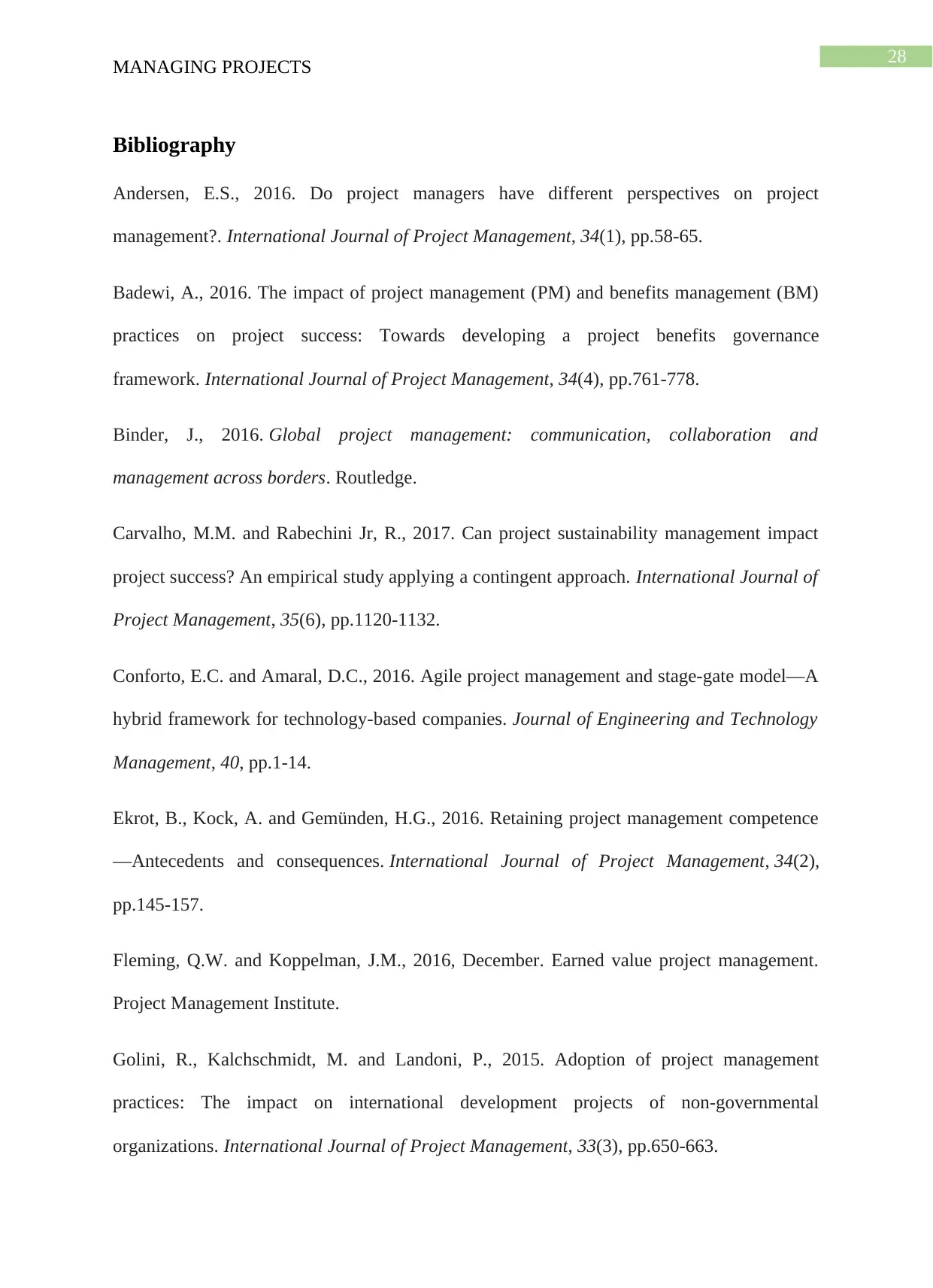
MANAGING PROJECTS
Bibliography
Andersen, E.S., 2016. Do project managers have different perspectives on project
management?. International Journal of Project Management, 34(1), pp.58-65.
Badewi, A., 2016. The impact of project management (PM) and benefits management (BM)
practices on project success: Towards developing a project benefits governance
framework. International Journal of Project Management, 34(4), pp.761-778.
Binder, J., 2016. Global project management: communication, collaboration and
management across borders. Routledge.
Carvalho, M.M. and Rabechini Jr, R., 2017. Can project sustainability management impact
project success? An empirical study applying a contingent approach. International Journal of
Project Management, 35(6), pp.1120-1132.
Conforto, E.C. and Amaral, D.C., 2016. Agile project management and stage-gate model—A
hybrid framework for technology-based companies. Journal of Engineering and Technology
Management, 40, pp.1-14.
Ekrot, B., Kock, A. and Gemünden, H.G., 2016. Retaining project management competence
—Antecedents and consequences. International Journal of Project Management, 34(2),
pp.145-157.
Fleming, Q.W. and Koppelman, J.M., 2016, December. Earned value project management.
Project Management Institute.
Golini, R., Kalchschmidt, M. and Landoni, P., 2015. Adoption of project management
practices: The impact on international development projects of non-governmental
organizations. International Journal of Project Management, 33(3), pp.650-663.
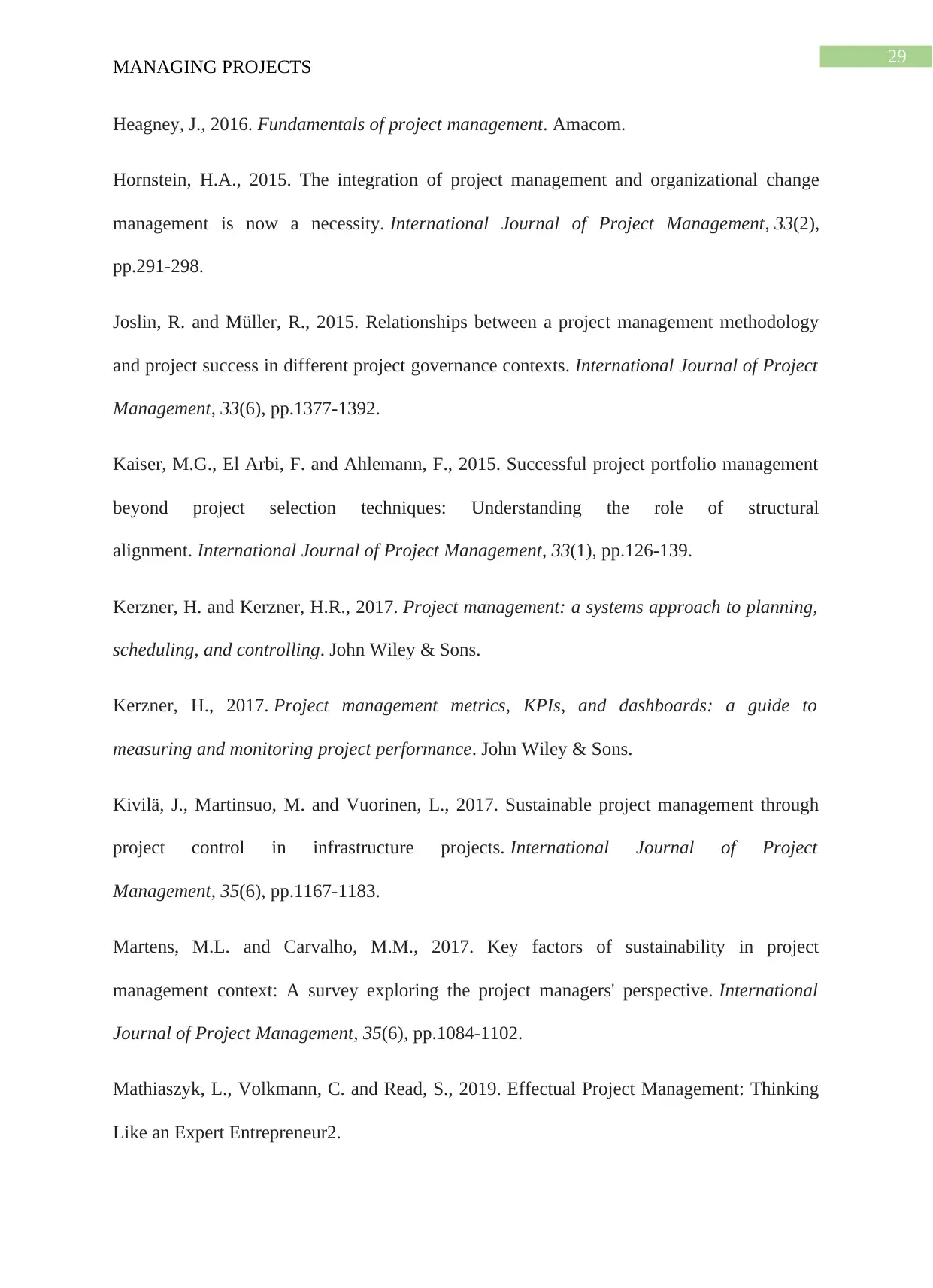
MANAGING PROJECTS
Heagney, J., 2016. Fundamentals of project management. Amacom.
Hornstein, H.A., 2015. The integration of project management and organizational change
management is now a necessity. International Journal of Project Management, 33(2),
pp.291-298.
Joslin, R. and Müller, R., 2015. Relationships between a project management methodology
and project success in different project governance contexts. International Journal of Project
Management, 33(6), pp.1377-1392.
Kaiser, M.G., El Arbi, F. and Ahlemann, F., 2015. Successful project portfolio management
beyond project selection techniques: Understanding the role of structural
alignment. International Journal of Project Management, 33(1), pp.126-139.
Kerzner, H. and Kerzner, H.R., 2017. Project management: a systems approach to planning,
scheduling, and controlling. John Wiley & Sons.
Kerzner, H., 2017. Project management metrics, KPIs, and dashboards: a guide to
measuring and monitoring project performance. John Wiley & Sons.
Kivilä, J., Martinsuo, M. and Vuorinen, L., 2017. Sustainable project management through
project control in infrastructure projects. International Journal of Project
Management, 35(6), pp.1167-1183.
Martens, M.L. and Carvalho, M.M., 2017. Key factors of sustainability in project
management context: A survey exploring the project managers' perspective. International
Journal of Project Management, 35(6), pp.1084-1102.
Mathiaszyk, L., Volkmann, C. and Read, S., 2019. Effectual Project Management: Thinking
Like an Expert Entrepreneur2.
⊘ This is a preview!⊘
Do you want full access?
Subscribe today to unlock all pages.

Trusted by 1+ million students worldwide
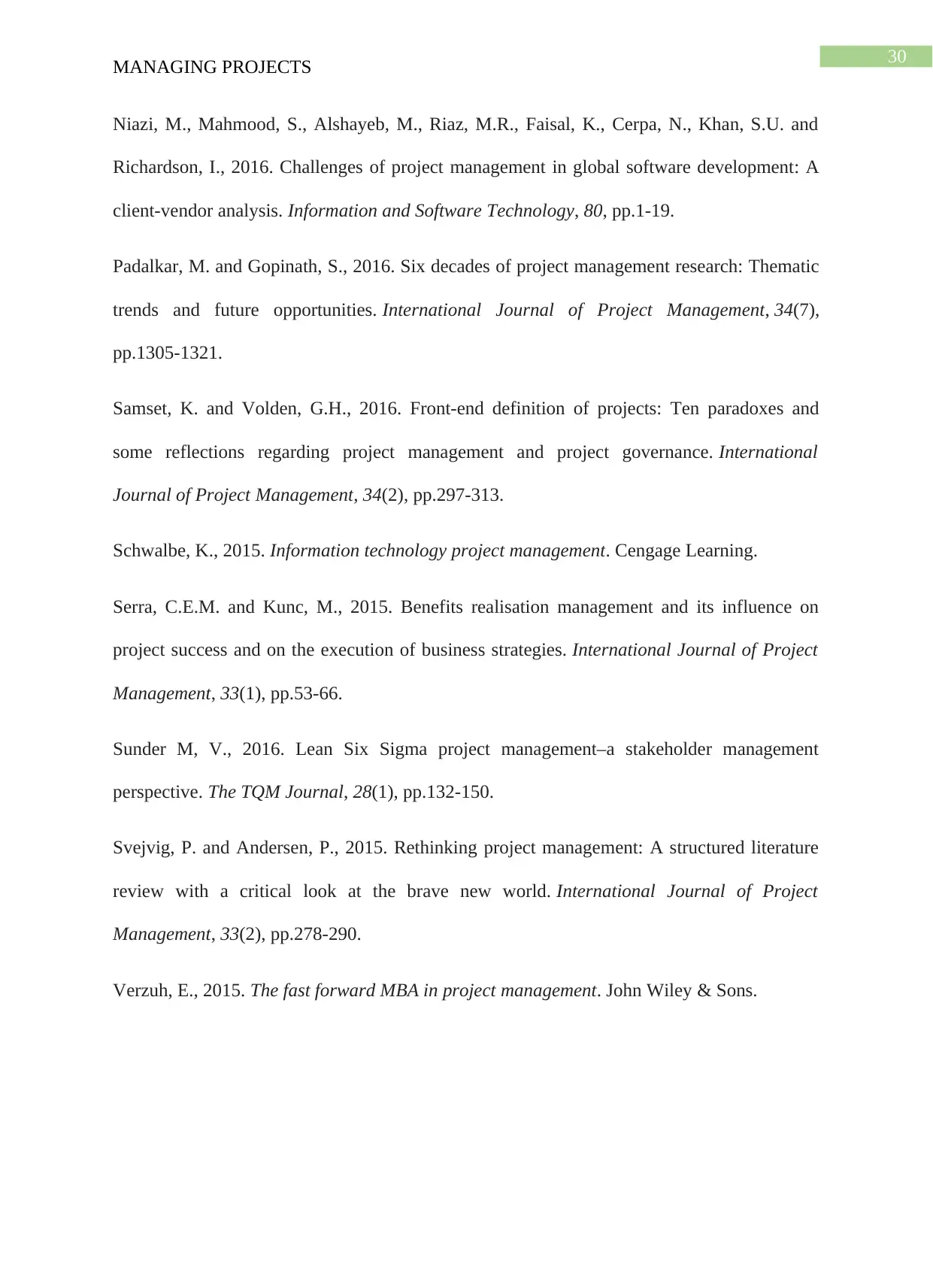
MANAGING PROJECTS
Niazi, M., Mahmood, S., Alshayeb, M., Riaz, M.R., Faisal, K., Cerpa, N., Khan, S.U. and
Richardson, I., 2016. Challenges of project management in global software development: A
client-vendor analysis. Information and Software Technology, 80, pp.1-19.
Padalkar, M. and Gopinath, S., 2016. Six decades of project management research: Thematic
trends and future opportunities. International Journal of Project Management, 34(7),
pp.1305-1321.
Samset, K. and Volden, G.H., 2016. Front-end definition of projects: Ten paradoxes and
some reflections regarding project management and project governance. International
Journal of Project Management, 34(2), pp.297-313.
Schwalbe, K., 2015. Information technology project management. Cengage Learning.
Serra, C.E.M. and Kunc, M., 2015. Benefits realisation management and its influence on
project success and on the execution of business strategies. International Journal of Project
Management, 33(1), pp.53-66.
Sunder M, V., 2016. Lean Six Sigma project management–a stakeholder management
perspective. The TQM Journal, 28(1), pp.132-150.
Svejvig, P. and Andersen, P., 2015. Rethinking project management: A structured literature
review with a critical look at the brave new world. International Journal of Project
Management, 33(2), pp.278-290.
Verzuh, E., 2015. The fast forward MBA in project management. John Wiley & Sons.
Related Documents
Your All-in-One AI-Powered Toolkit for Academic Success.
+13062052269
info@desklib.com
Available 24*7 on WhatsApp / Email
![[object Object]](/_next/static/media/star-bottom.7253800d.svg)
© 2024 | Zucol Services PVT LTD | All rights reserved.





